Feed your imagination


ISSUE 153 DISTRIBUTED WITH THE MALTA INDEPENDENT ON SUNDAY FEBRUARY 2023




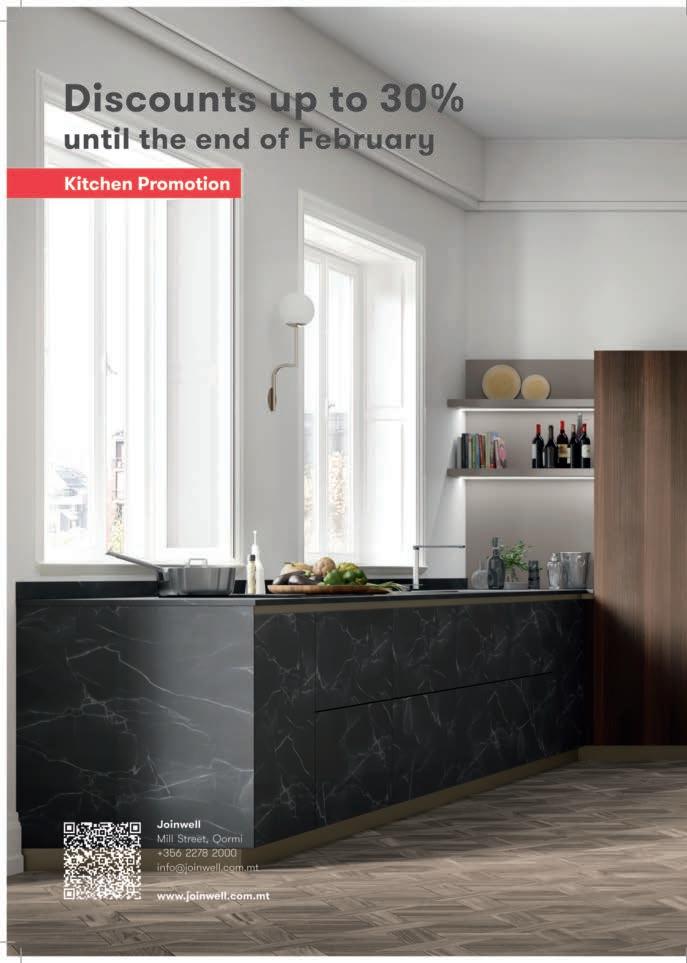

As the vernacular saying goes, Frar ifawwar il-bjar. And so it has. A er a prolonged spell of dryness and unseasonal warmth that saw early spring shoots arrive before their time, air temperatures have dropped. Just as we were running out of time for winter to start, heavy rains have arrived, clearing the air and filling the proverbial wells. When it’s cold and wet outdoors, there’s no be er place to be than in a warm kitchen, and nothing more comforting than coming home to the scent of good home cooking. For our first issue of 2023, Michael Diacono invited us into his family home and cooked up a medley of dishes with wonderful flavours, using one of Malta’s favourite ingredients. Claire Borg went down to her family’s field to harvest a basketful of seasonal produce which she turned into a feast of traditional Gozitan and family recipes. Our inhouse kitchen turned out an array of desserts that are fun to make and even more fun to share. Andrew Azzopardi looked further afield, exploring how the boundaries of wine quality have shi ed over recent years. In our design pages, read about how a firm of young architects rethought the architecture of a villa with open views that dates back to the “noughties” (unbelievably, that was 20 years ago). At the other end of the scale, take a look at an innovative design approach to compact living in Valle a. We wrap up this issue with a peek at a once-in-lifetime exhibition. We will be back in early April with another fabulous issue of Taste&Flair.
If you missed any issue of Taste&Flair and want a copy, we may be able to help so please do get in touch with us by email, Messenger, or on Instagram.
Publisher
The Daphne Caruana Galizia Foundation 56 Melita Street, Valletta VLT1122, Malta
Editorial Board
Paul Caruana Galizia
Andrew Caruana Galizia
Matthew Caruana Galizia
Executive Editor Corinne Vella
Editorial Assistants
Megan Mallia • Amy Mallia
Art Director Ramon Micallef +356 9949 1418 ram@box-design.net
Advertising Manager & Editorial Contributor
Sean Ellul +356 7921 0705 sellul@independent.com.mt
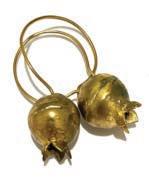
Advertising Assistant Christine Mifsud +356 21 345 888 ext 138 cmifsud@independent.com.mt
Production Manager André Camilleri
Production Assistant Conrad Bondin
Prepress & Printing Print It
All communication about Taste&Flair magazine should be directed to Corinne Vella at corinne.vella@gmail.com

No part of any issue of Taste&Flair may be reproduced without the wri en prior agreement of the publisher.

Distributed with The Malta Independent on Sunday*. The Malta Independent on Sunday is published by Standard Publications Ltd - Tel +356 21 345 888
*The surcharge on The Malta Independent on Sunday, or any charge for this magazine is retained by Standard Publications Ltd.
Follow Taste&Flair on
6 ISSUE 153 FEBRUARY 2023 EDITORIAL
C
e
i
View of Delft, Johannes Vermeer, 1660-61, Mauritshuis, The Hague. The painting of the artist’s home town is currently on display at the Rijksmuseum as part of the Vermeer retrospective that opened this week (see article on page 80).
Pomegranate Verrines
&
photo by Corinne Vella. See feature on page 46
GOLDEN KROCUS

 KOZANIS KROCUS, NATURE'S MOST PRECIOUS ANTIOXIDANT
KOZANIS KROCUS, NATURE'S MOST PRECIOUS ANTIOXIDANT




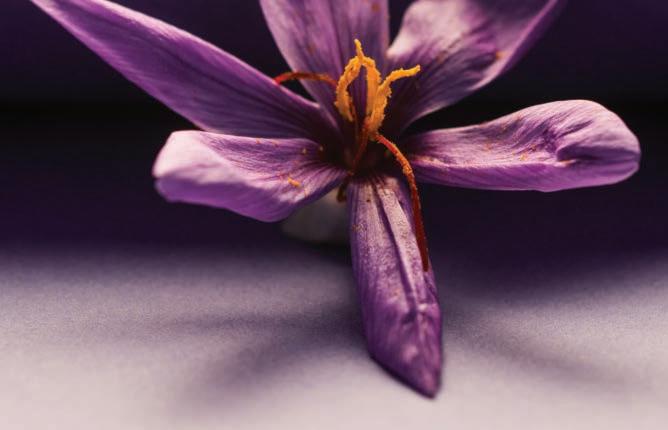
The Saffron Flower, else known as the Krocus Flower, growing in Kozani, North Greece is a unique flower with a beautiful story to tell. Farmed organically by locals who carry out the century old tradition to this day, Krocus blossoms only once a year, every October, for barely two weeks, creating a purple magic carpet as far as the eye can see. The flowers are harvested daily, right after the morning dew has evaporated, and saffron antioxidants are at their peak. After all the flowers have been collected, the fields look empty, but by dawn, the Krocus blooms once again, blanketing the fields in beautiful purple flowers. Petals are separated by hand from the saffron stigmas and stamens, immediately after being picked, followed by stigmas’ drying process, ensuring that the saffron is at its highest potency for the Golden Krocus elixir. A hundred and fifty thousand blooms handpicked by the villagers during the harvest, yield only one kilo of Krocus stigmas. And it’s those stigmas separated one-by-one by hand, that give us this precious and immensely powerful elixir.
Strengthen and protect the delicate eye area with this nourishing and powerful botanical booster. Beta-glucan polysaccharide moisturises deeply while working to support skin´s natural defense against external factors. Low molecular weight hyaluronic acid delivers a deep dose of hydration, plumping and lifting the eye area.
Restore a youthful glow with the KORRES Golden Krocus Ageless Saffron Elixir; a precious, antiageing elixir that works to repair, hydrate and rejuvenate your complexion.



Your most powerful golden youth-cream with plant collagen that melts into your skin reducing the appearance of all visible signs of aging skin with a time-released hydration complex for 48 hour continuous hydration.


KorresMalta MORE PRECIOUS THAN GOLD us and
GOLDEN KROCUS AGELESS SAFFRON EYE ELIXIR
GOLDEN KROCUS AGELESS SAFFRON FACE ELIXIR
GOLDEN KROCUS HYDRA FILLER PLUMPING CREAM
Exclusively distributed by AM Mangion Ltd | Tel: +356 2397 6000 remediespharmacies.com | www.korres.com
At home with Michael Diacono
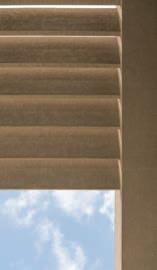
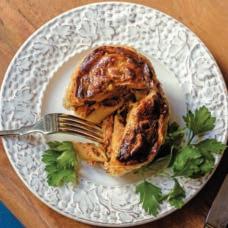






Claire Borg’s pick of the crop from her family’s field
Andrew Azzopardi explores the shi ing geography of wine quality


8 ISSUE 153 FEBRUARY 2023 T&F CONTENTS
comfort
14 Home
harvest
28 Fresh
New World vs Old
44
46 Sweets & desserts
56 Building relations
living in Valletta
Satisfy your sugar craving
A noughties family home gets a fresh new look 68 Compact
pg14 pg28 pg68 pg46 pg56 pg44
Innovative design approach in a historic city 80 Vermeer The once-in-a-lifetime retrospective


Triq L-Imdina, Zone 2, Central Business District, Birkirkara T. 2546 4000 | info@oxfordhouse.com.mt www.oxfordhouse.com.mt
Timeless & stylish bedroom designs

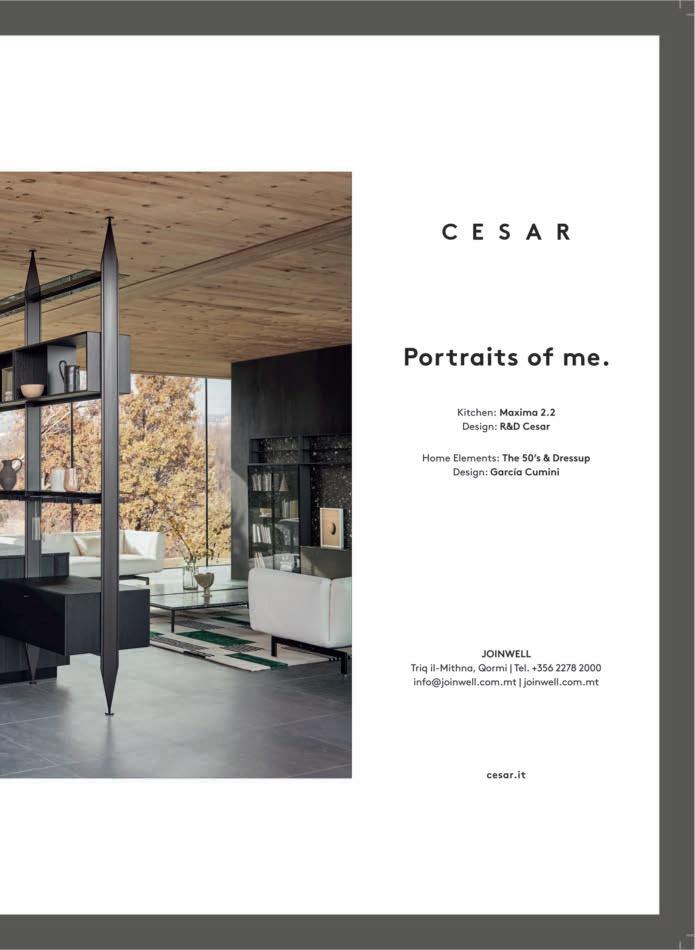
a designer’s dream kitchen
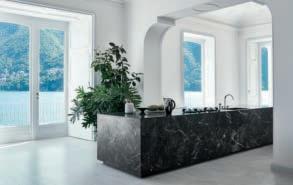
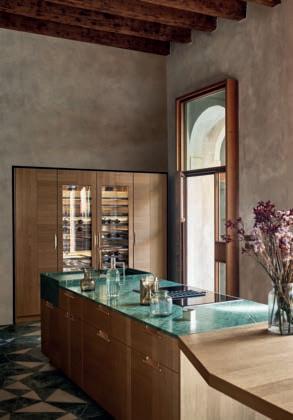
CESAR has established itself as one of the leading Italian companies in the field of kitchen design and production. CESAR has its roots in the furniture manufacturing hub which is Veneto; precisely, in the town of Pramaggiore, in the workshop of Sante Cester. It came of age in 1968 and now boasts three flagship stores - in Milan, New York, and Paris - on top of 200 Italian sales outlets and 180 international dealers. After an extensive review of the Maltese furniture industry, CESAR chose to appoint the merging Joinwell & FXB companies as its sole dealership for the islands of Malta &Gozo.
CESAR’s artistic direction has been, in part, under the responsibility of Garcia Cumini Associati, a leading design studio, since 2014. During this time, CESAR’s mantra has been to create kitchens focused on wellness, beauty, and efficiency, in which the kitchen becomes the emotional centre of the home, reflecting the inner beauty and harmony of the individuals to whom it belongs.

CESAR’s wide range of modules, materials, and finishes creates a haven for bespoke solutions. Highperformance technical finishes, as well as natural materials, are available to both contemporary and traditional collections, eliminating the need for designers
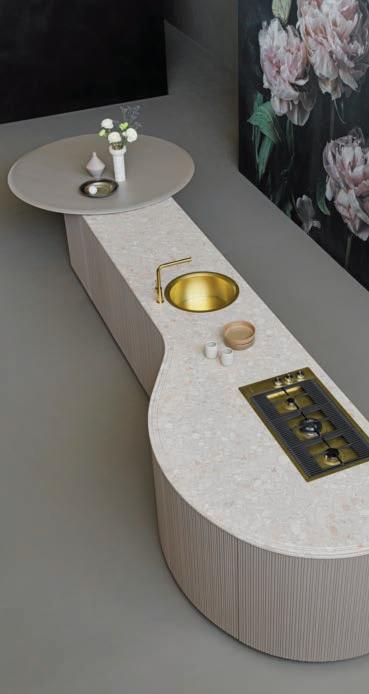
12 ISSUE 153 FEBRUARY 2023 & PROMOTION
Cesar Intarsio Rovere Mediterraneo.
Photo credits: Andrea Ferrari, Styling: Studiopepe.
Cesar N elle Grigio Carnico marble.
Photo credits: Andrea Ferrari, Styling: Studiopepe. Cesar Tangram Quarzo structured lacquer.
to have to make compromises as they seek to blend their quest for artistic beauty with their customers’ similar requirements as well as the need for day to day functionality and comfort. CESAR’s choice of the JoinwellFxb team was also attributable to CESAR’s commitment to a privileged relationship with its clients, not only guaranteeing all of its products for 5 years, but also guaranteeing a rapid and precise response to every demand subsequent to the sale. Furthermore, CESAR wants all of its customers to have the facility to enhance and build on their investment in a premium kitchen with the passage of time.

At the Joinwell showroom in Qormi, a er months of studying and discussing the local furniture sector, CESAR and JoinwellFxb have chosen to display CESAR’s UNIT, MAXIMA 2.2, TANGRAM, and THE 50’S kitchens. Innovation, clean lines, versatility, and functionality within contemporary and elegant styles are but just a few of the features one can see and touch before proceeding to customise them to one’s own space and functional requirements. CESAR’s local customers, and their own interior designers, then have JoinwellFxb’s vastly experienced design team, fully backed by CESAR’s design and technical teams, looking forward to helping them create their unique and dream kitchen. n
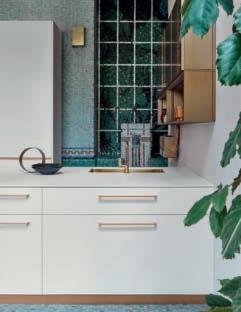
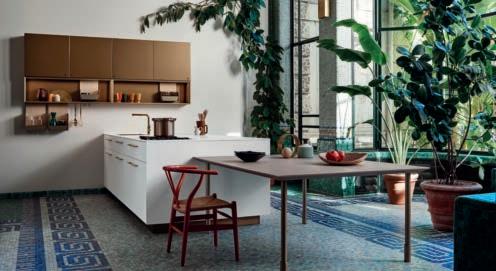

13 ISSUE 153 FEBRUARY 2023 PROMOTION &
Cesar Unit Rosso Jaipur Fenix.
Photo credits: Andrea Ferrari, Styling: Studiopepe.
Cesar Maxima 2.2 Meringa technomat, fenix Bianco Kos.
Photo credits: Andrea Ferrari, Styling: Studiopepe.
Cesar Maxima 2.2 Meringa technomat, fenix Bianco Kos.
Photo credits: Andrea Ferrari, Styling: Studiopepe.
There’s nothing quite as soothing as coming home to welcoming warmth and a satisfying meal.
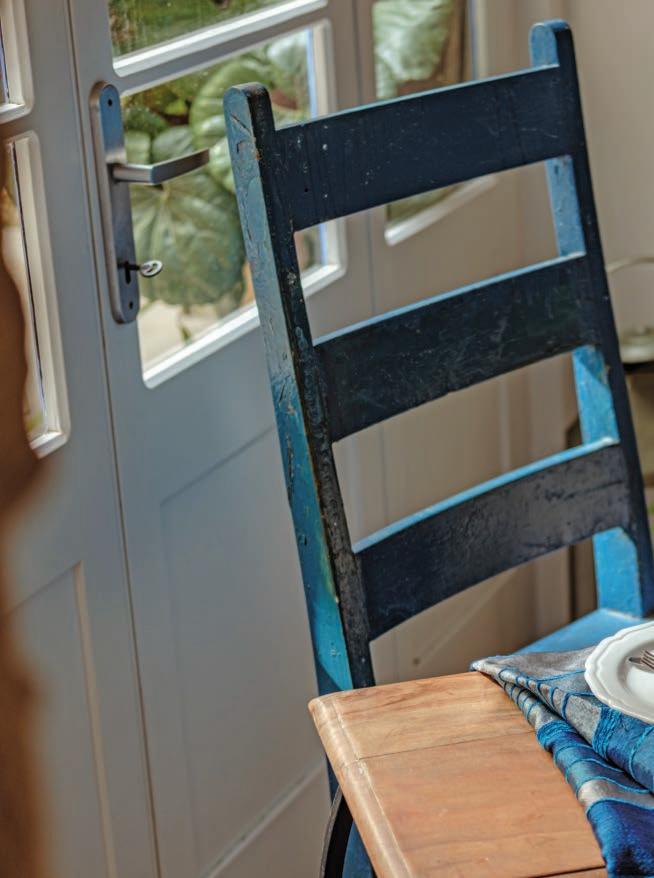
Food: Michael Diacono, chef patron, Giuseppi’s Bar and Bistro
Styling and photography: Brian Grech
Wine recommendation: Andrew Azzopardi, Vintage 82
14 ISSUE 153 FEBRUARY 2023 & FAMILY MEALS
For our first edition of 2023 I decided to focus on what is without doubt Malta’s number one ingredient –rabbit. It is delicious simply fried with loads of garlic, bay leaves, and wine, or gently stewed in a rich tomato sauce. These would be the most popular ways of preparing rabbit for most, but this lean, white meat is very versatile and lends itself to so many different ways of cooking.


15 ISSUE 153 FEBRUARY 2023 FAMILY MEALS &
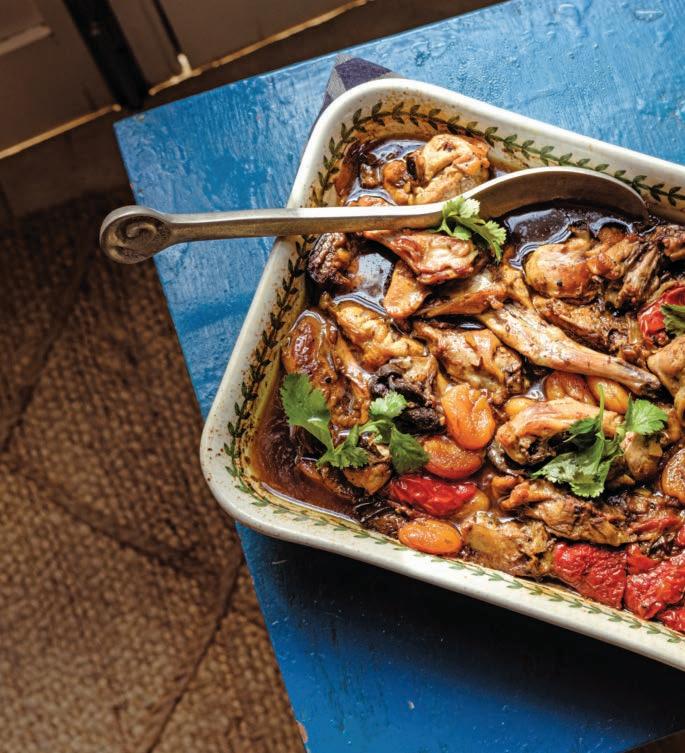
16 ISSUE 153 FEBRUARY 2023 & FAMILY MEALS
Serves 3-4
PREPARATION AND COOKING: 90 minutes RECOMMENDED WINE: Fruitfroward Provence-style Rosé
YOU WILL NEED:
16 dried apricots, soaked in warm water for 20 mins, then drained
1 rabbit, jointed
1 large onion, peeled and sliced
6 garlic cloves, peeled and chopped
1 sweet red pepper, cleaned and sliced thickly
2 heaped teaspoons sumac
1 teaspoon cumin seeds
2 cinnamon sticks
1 chili, chopped
12 black olives
salt and pepper
300ml water
1. Preheat the oven to 185°C. Place all the ingredients into an oven-proof ceramic dish, just large enough to hold everything. Cover the dish with baking paper and then with foil.
2. Let the dish bake for 45 minutes then uncover it and let it continue cooking for another 20 minutes.
3. Serve this at once, accompanied by a steamed couscous.

17 ISSUE 153 FEBRUARY 2023 FAMILY MEALS &
There are such wonderful avours in this dish. It is rich, sweet, and tangy, and delightfully easy to make.
I would describe this as elegantly rustic. I always keep the carcass a er roasting a chicken and use it to make a delicious stock or broth.
Serves 6
PREPARATION AND COOKING: 150 minutes
RECOMMENDED WINE: A light bodied Beaujolias Cru or an unoaked Chardonnay/ Pinot Gris would work well.
YOU WILL NEED:
1 whole chicken carcass left over after roasting, broken down into pieces
4 chicken necks
1 onion, peeled and chopped
1 large carrot, scraped and chopped
a few leaves and stalks of karfus
salt
10 peppercorns
2l water
For the dumplings (you will have extra, they freeze very well for another time)
400g fresh breadcrumbs
2 rabbit livers, finely chopped
1 shallot, finely chopped
a handful parsley, finely chopped
1 teaspoon fresh thyme
salt and pepper
4 eggs
flour to coat
1. Place the chicken carcass into a stock pot and pack the rest of the ingredients around it. Add the water. Place the pot on the heat and bring it to the boil then reduce the heat drastically so that the water just simmers.
2. Leave the pot uncovered and let it simmer for 2 hours, topping up as necessary to keep all the ingredients covered in water. Strain the broth into a clean pot. Should you wish, you may then cook a sliced carrot in the broth for 10 minutes.
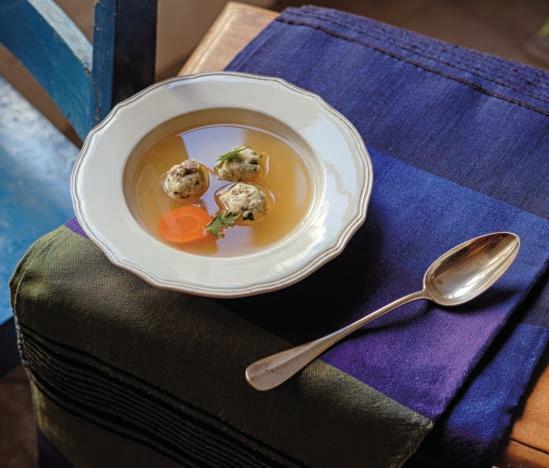
3. To make the dumplings, mix the ingredients together then, using damp hands, roll the mixture into small balls. Roll these in flour and keep them in the fridge till needed.
4. To serve, poach the dumplings in the gently boiling broth for 4-5 minutes.
18 ISSUE 153 FEBRUARY 2023 & FAMILY MEALS

YOU WILL NEED:
50g dried porcini
mushrooms soaked in enough warm water to cover them
300g guanciale, cubed (1cm)
2 onions, peeled and finely chopped
1 carrot, scraped and finely cubed
½ teaspoons cumin seeds

800g rabbit meat, chopped
150g rabbit liver, chopped
200g chicken hearts, chopped salt and pepper
200ml dry white wine
3 fresh bay leaves
2 tins tomato polpa
1 scant tablespoon sugar
150g grated Parmesan
3 eggs
600g shortcrust pastry
400g puff pastry butter or spray oil to grease
500g mezze penne (small)
2 eggs to seal and glaze
1. While the porcini mushrooms are soaking, add the chopped guanciale to a large sauce pan. Cook on high heat to render the fat and colour the meat well. It should brown well and start to smoke.
2. Add the chopped onion and carrot and stir fry for a few minutes to so en. Next, add the cumin. Cook it for 1 minute then add the rabbit, the liver, and the chicken hearts. Season well and cook on high heat to brown, stirring o en. Add some extra-virgin olive oil, should it be needed. Cook till the meat is coloured, then douse the mixture with the wine and let it evaporate.
3. Add the bay leaves and porcini mushrooms together with the soaking water which you should run through a fine sieve.
4. Stir the mixture and bring it to the boil before adding the polpa. Fill one of the cans with water and use it to rinse out the second can too before adding that to the sauce. Regulate the sauce’s acidity with some sugar. When the sauce starts to boil, reduce to heat, cover the pan and let it simmer gently for 2 hours.
5. Grease ten 6cm dariole moulds well with bu er or lots of spray oil.
6. Boil the pasta in salted water for half the recommended cooking time, then drain it. Transfer the cooked pasta to a large bowl and add enough sauce to coat it very well before adding the Parmesan and the 3 eggs. Stir well and check and adjust the seasoning.
7. Roll out the shortcrust pastry on a flour surface till it is about 4mm thick. Cut out large rounds and use to them to line the moulds, leaving a small overhang. Fill the moulds with the seasoned pasta. Brush the edge of the pastry overhang with egg.
8. Roll out the puff pastry too and cut out smaller rounds to cover the timbales. Press the edges of the pastry together and crimp them to seal them Brush the tops with beaten egg to glaze. Prick the surface twice with a fork to allow steam to escape during cooking.
9. To cook, bake the timbales in a preheated oven at 190°C for 25 minutes till risen and golden all over. Freeze any extra sauce in rigid plastic containers for future use.
Make these for that special Sunday lunch. Yes, they do take time to prepare, and yes, they might be a bit ddly too, but they are so worth the e ort. The sauce is typical old-style sumptuousness and is grand served on fettuccine too, so here I am giving ingredients for a much bigger amount than needed. The extra sauce can be frozen and used as needed.
Serves 10 (plus extra sauce f freezing)
PREPARATION AND COOKING: 180 minutes
RECOMMENDED WINE: A Tuscan Chianti or Montepulciano d’Ambruzzo
20 ISSUE 153 FEBRUARY 2023 & FAMILY MEALS
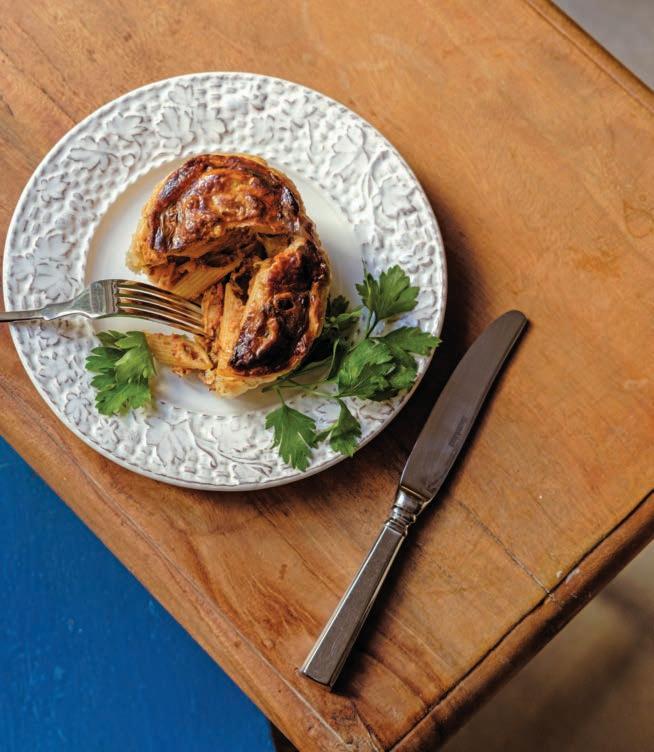
21 ISSUE 153 FEBRUARY 2023 FAMILY MEALS &
For me, there is something so satisfying about cooking risotto. The whole process is slow and, as it’s a pot-to-plate dish, it must be made at the last minute so normally if I have guests at home they are in the kitchen too, sipping wine while I stir away.

Serves 6 (as starter)
PREPARATION AND COOKING 60 minutes
RECOMMENDED WINE: “Classic Bordeaux, and in particular Right-bank Merlot based is a great pairing. Alternatively, a New World Pinot Noir would be a wonderful option.”
YOU WILL NEED:
150g unsalted butter
1 medium onion, finely diced
2 cloves garlic, finely chopped
1 carrot, peeled and finely diced
1 stick celery, finely diced
500g rabbit bellies, chopped
salt and pepper
2 fresh bay leaves
400g arborio rice
375ml dry white wine
1.5l hot rabbit or chicken stock
350g frozen porcini, defrosted
200g grated Parmesan
1. Melt about 70g of the bu er in a heavy based pot. Add the onion and garlic and stir fry on medium heat for a few minutes to so en.
2. Add the chopped carrot and celery. Cook for about 3-4 minutes, stirring very o en till the vegetables begin to brown slightly.
3. Add the chopped rabbit bellies and season with salt and pepper. Stir fry for a few minutes.
4. Add the bay leaves then the rice. Stir the mixture till the rice is coated and cook for 1 minute before dousing with the white wine. Evaporate the wine rapidly then start adding the hot stock gradually, stirring all the time till you use it up. The rice should be al dente.
5. Now, toss in the defrosted porcini. Add the grated cheese and stir it in, then add the rest of the bu er and stir till all melted. Cover the pot and let it rest for 1 minute before serving.
22 ISSUE 153 FEBRUARY 2023 & FAMILY MEALS

Whenever we had any le over ravioli at home, my wife Janine would fry them up in the evening for the kids as a special treat. These are great to serve with drinks before a meal as an unusual appetiser. As a starter or main course, these ravioli may be either fried or boiled in salted water. I served these fried with shavings of ricotta salata.
Serves 6
PREPARATION AND COOKING: 120 minutes, including resting time
RECOMMENDED WINE: Champagne or ‘traditional-method’ sparkling wine such as Cava or Cap Classique

24 ISSUE 153 FEBRUARY 2023 & FAMILY MEALS
FOR THE FILLING:
3 tablespoons extra-virgin olive oil
1 medium onion, peeled and finely chopped
2 cloves garlic, peeled and finely chopped
1 small carrot, scraped and very finely chopped
1 stalk celery, very finely chopped
400g minced rabbit meat
salt and pepper
200ml dry red wine
2 sprigs rosemary, finely chopped
1 teaspoon thyme
50g grated Parmesan
FOR THE PASTRY:
400g plain flour, sifted
4 eggs
1 tablespoon extra-virgin olive oil
½ teaspoon salt
YOU WILL ALSO NEED: beaten egg to seal the pastry vegetable oil for frying ricotta salata for serving
1. Heat the extra-virgin olive oil in a pan and stir fry the onion, garlic, carrot, and celery together till they start to brown, then remove them from the pan and set them aside.
2. Add some oil to the pan and add the rabbit mince. Season the meat and fry it to brown it, then put the vegetables back in the pan.
3. On a high heat, add the wine and let it evaporate while scraping at the bo om of the pan to loosen any stuck bits, which are full of flavour. Add the herbs. Remove the pan from the heat and let it cool before adding the cheese.
4. Prepare the pastry in the usual manner and let it rest for 1 hour before rolling it out very thinly on a floured surface (or use a pasta machine).
5. Cut out ravioli shapes and fill them with the prepared mixture. Brush the edges of the pastry with beaten egg and press them together to seal.
6. Place the ravioli onto a flat tray dusted with flour and let them rest in the fridge for 1 hour before deep frying them in hot clean vegetable oil. I served these with shavings of rico a salata.
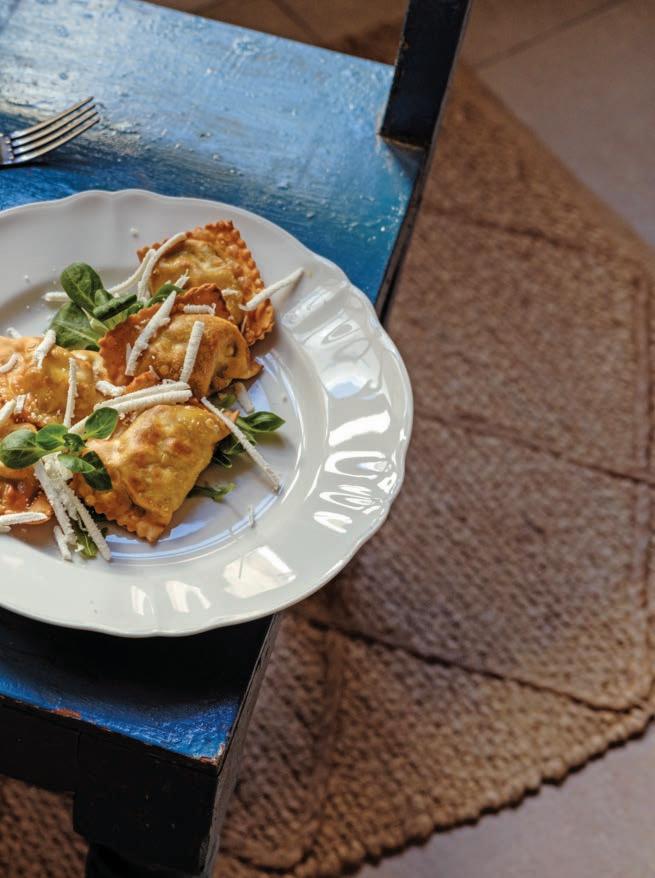
25 ISSUE 153 FEBRUARY 2023 FAMILY MEALS &
So many people I know would not cook rabbit at home as they say frying it on a high heat makes too much of a mess. That is true. Roasting works wonders, though. Prepare the rabbit in the morning, leave to marinate throughout the day, then simply pop it into the oven in the evening.
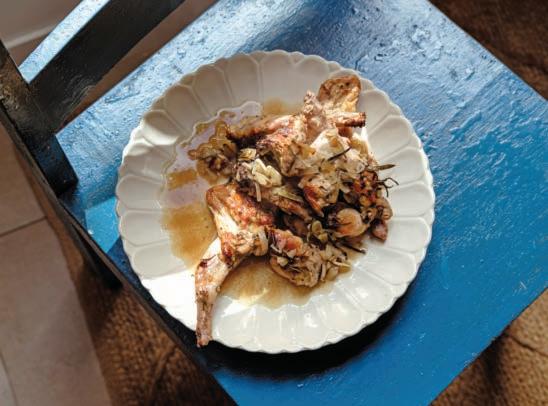
Serves 3-4
COOKING: 60 minutes, plus 6 hours or to marinate
RECOMMENDED WINE: Northern Rhone-Style Syrah including Hermitage or Côte Rôtie
YOU WILL NEED:
1 rabbit, jointed
1 large leek cleaned and chopped
4 cloves garlic, peeled and chopped
5 sprigs fresh rosemary
3 tablespoons pure maple syrup
salt and pepper
450ml dry white wine
2 tablespoons extra-virgin olive oil
1. Place the rabbit into a large baking dish and add the chopped leek and garlic. Push the rosemary in between the pieces of meat. Drizzle the maple syrup over the meat and season it well. Pour the wine all over the mixture and finally pour in the extra-virgin olive oil.
2. Cover the dish with a piece of baking paper and then with a large piece of foil. Leave it in the fridge for at least 6 hours.
3. Remove the dish from the fridge and let it come to room temperature (about 30 mins). Meanwhile preheat oven to 185°C.
4. Bake the rabbit dish for 45 minutes before uncovering it, then continue to let it roast for a further 15 minutes until the meat browns. Serve at once.
26 ISSUE 153 FEBRUARY 2023 & FAMILY MEALS

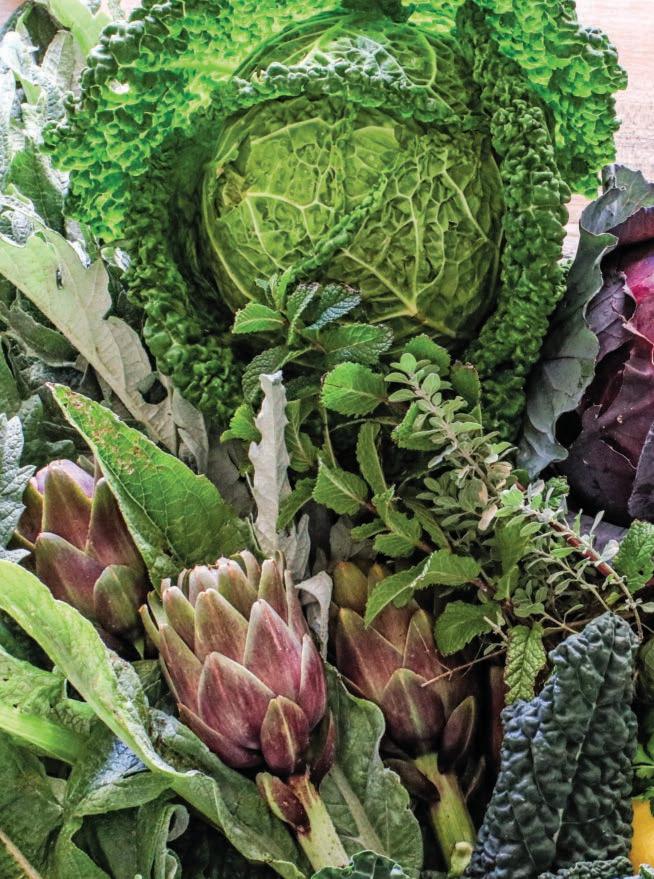
28 ISSUE 153 FEBRUARY 2023 & IN SEASON
FRESH FROM THE FIELD


February rain washed away the dryness of January and ushered in the season for hearty home cooking. Claire Borg harvested fresh produce, cooked it in a marathon a ernoon session, and photographed the end result.



Most of the produce in this feature came from our field in Gozo. For the first issue of Taste&Flair this year, I wanted to cook fresh, seasonal vegetables, bursting with colour and flavour. When I began cooking for the magazine, I worked closely with Daphne and even now, she is there every time I work, every time I style, every time I cook, every time I work for the magazine. She is in my heart. And when I shot the purple dish, the sun came out and lit up the room.

29 ISSUE 153 FEBRUARY 2023 IN SEASON &
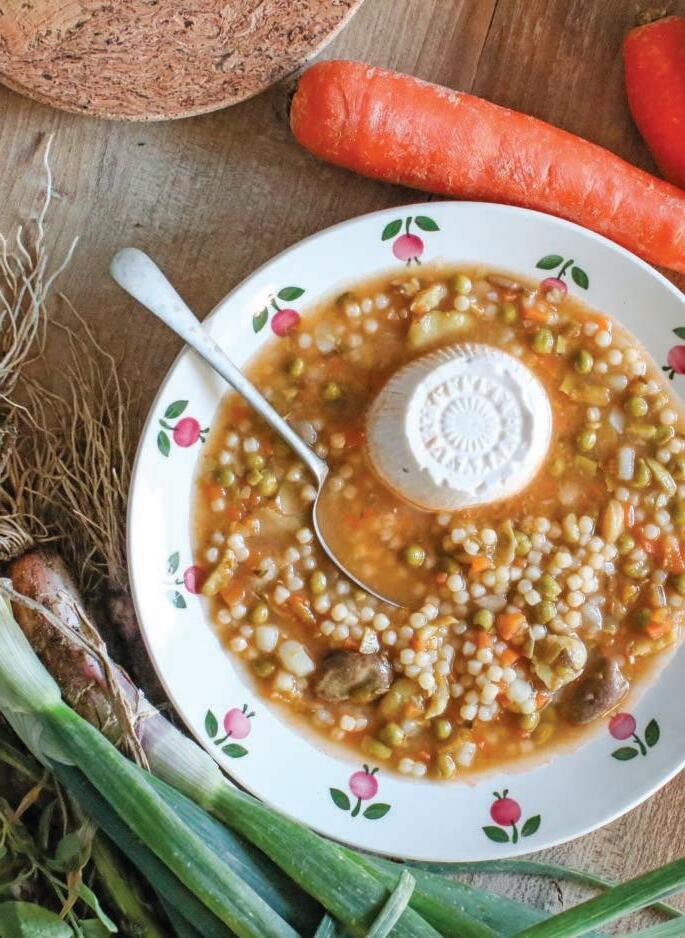
30 ISSUE 153 FEBRUARY 2023 & IN SEASON
A perennial favourite, this warming soup can be made in advance and stored in the fridge until needed. The trick is to add the ‘kisksu’ pasta and cheeselets just a few minutes before serving. If you want a creamy soup, peel both skins o the broad beans. I like to use a mixture - half totally peeled and some with the second skin on.
YOU WILL NEED:
4 full cups of peeled broad beans
1 cup of fresh peas (or frozen, if fresh are not available)
1 large onion
2 large carrots
2 medium potatoes
100 grams of ‘kisksu’ pasta, peppercorn size
4 fresh sheep cheeslets (ġbejniet)
1 -2 heaped tablespoons tomato paste (kunserva)
2 l water
cooking oil
salt and pepper
1. Peel and finely chop the onion and carrots. Peel and finely dice the potatoes.
2. In a soup pot, cook the onion in a li le oil. Add the carrot and cook further. Add the tomato paste, heat through, and then add the rest of the vegetables.
3. Meanwhile, bring the water to the boil and add to pot right a er adding all the vegetables. Season with salt and pepper. Turn the heat down to a gentle simmer, cover the pot and let it simmer for about 40 minutes.
4. If you are not serving all the soup at once, ladle the amount you will need to serve into another pot and set the rest aside to cool. Add the pasta and cheeselets to the fresh pot, set it on the heat, and let it cook for another 13-15 minutes.
5. Store the le over soup without pasta in the fridge until needed. To serve, first warm up the basic soup, then add ‘kisksu’ pasta and cheeselets and let them cook for 13-15 minutes before serving piping hot.

31 ISSUE 153 FEBRUARY 2023 IN SEASON &
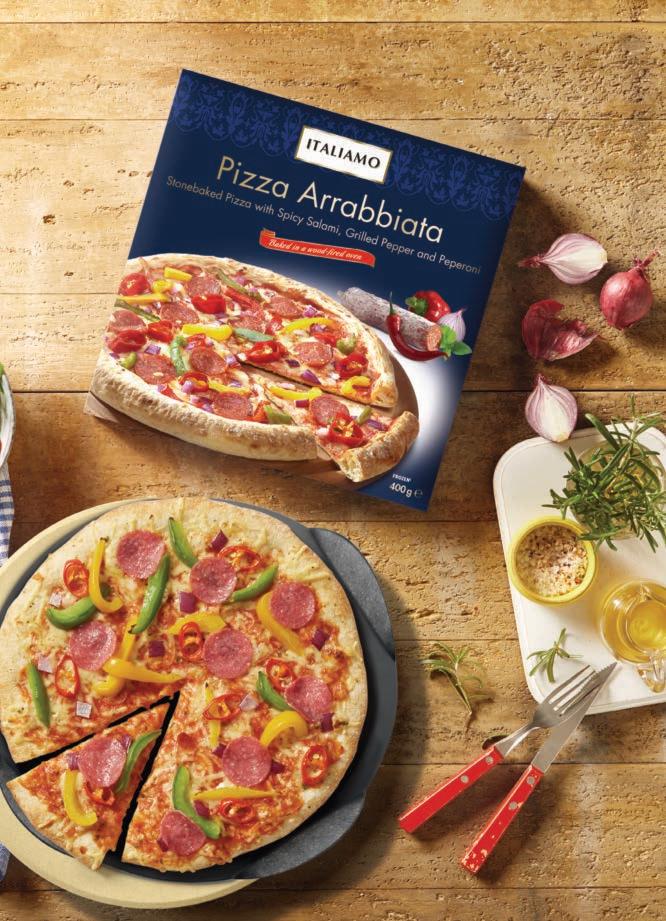









FLAVOURS FROM THE WORLD Big on Quality, Lidl on Price from Monday 13TH February Italiamo Pizza “Arrabbiata” With spicy salami, grilled pepper and peperoni frozen 1kg = € 8.73 3.49 400g pack 1 kg = € 7.90 2.49 315g pack Italiamo Pizza “Cacio e Pepe” With cheese and pepper frozen Italiamo Pizza With cream of asparagus, provolone and Speck from Alto Adige PGI or with “Caciocavallo Silano PDO Cheese” and taggiasche olives 1 kg = € 7.67/7.29 2.99 390/410g pack frozen
Fresh-tasting and crunchy-textured, this salad is quick and easy to make and a wonderful accompaniment to grilled sh or white meat.
Serves 6 as a side
YOU WILL NEED:
½ a savoy or white cabbage
½ a red cabbage
20 white seedless grapes
10 dried figs
100g raw almonds
50g pumpkin seeds
a handful of dill
a handful of parsley
1 tablespoon lemon zest
juice of 1 lemon
1 tablespoon whole grain mustard
6 tablespoons olive oil salt
TO SERVE grated goat cheese
1. First, prepare the main ingredients. Wash and finely shred the cabbages and finely slice the figs and almonds.
2. To make the dressing, whisk together the mustard, lemon juice, and olive oil.
3. Wash the herbs and chop them finely. Mix all the ingredients together, drizzle in the dressing, and toss the salad. Season and serve at once with grated goat cheese on the side.
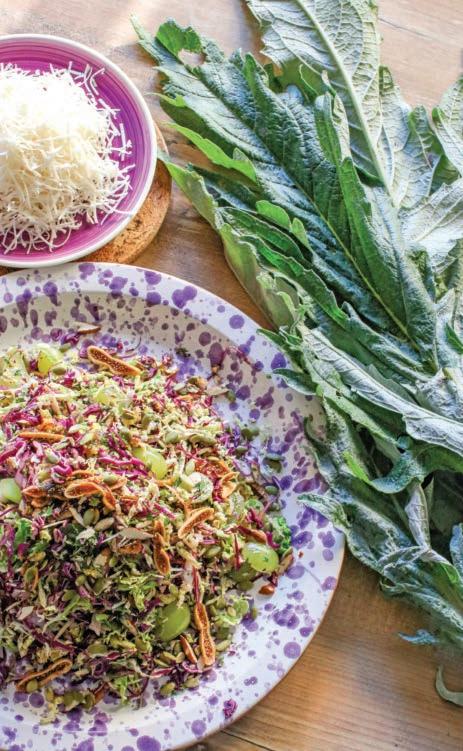
33 ISSUE 153 FEBRUARY 2023 IN SEASON &
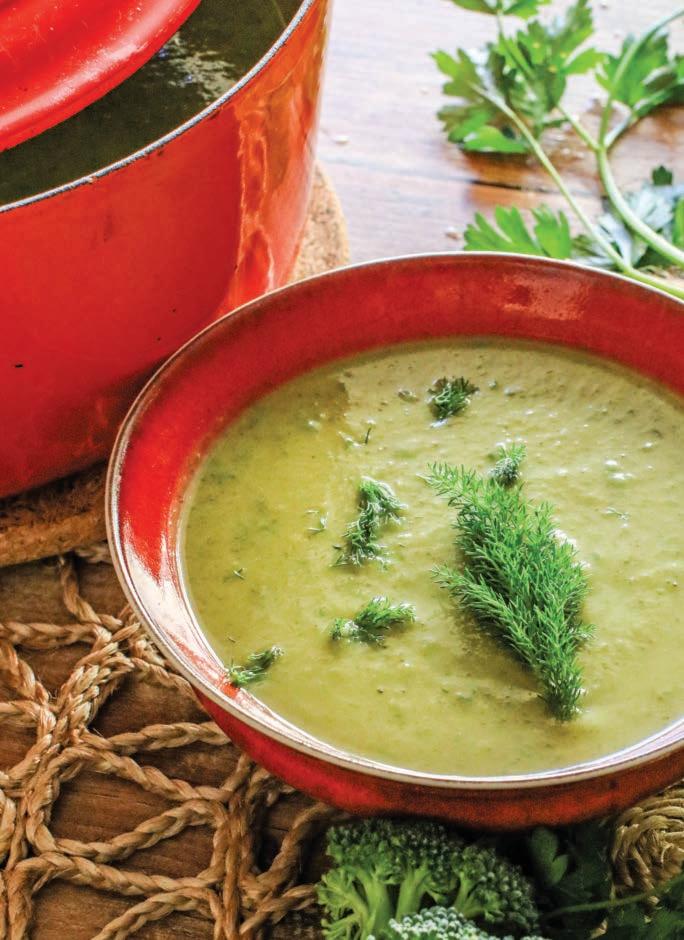
34 ISSUE 153 FEBRUARY 2023 & FRESH
This will be enough f 4 to 5 people
YOU WILL NEED:

1 head of broccoli
250g Jerusalem artichokes
2 pieces of fresh garlic
1 onion
4 sticks of lemon grass
1.5 l water
olive oil
salt and pepper
fresh herbs of your choice (I used some marjoram and wild fennel) a small handful of fresh parsley
1. Peel and roughly chop the vegetables, including the lemon grass.
2. Warm a soup pot, drizzle the inside base with olive oil and tilt the pot to make sure it is well coated. Sauté the onion in the warm oil until it so ens.
3. Add the garlic and herbs (but not the parsley) to the pot and cook for a minute, then add the roughly diced vegetables.
4. Bring the water to the boil, pour it into the pot. Season with salt and pepper and stir. Turn the heat down to a gentle simmer and let it cook for 40 minutes.
5. Remove and discard the lemon grass and blend the remaining mixture. Wash and finely chop the parsley and add it to the pot. Adjust the seasoning to taste before serving.

35 ISSUE 153 FEBRUARY 2023 IN SEASON &
A bowlful of warm, fresh, and earthy avours.
When it’s artichoke time, I always, clean and cook artichoke hearts and freeze them for use throughout the year. For this pasta dish you can also use frozen or tinned artichokes; however, I do suggest using precooked fresh ones. This recipe may also be enjoyed cold as a salad if made with a shorter pasta.
This recipe serves 2
YOU WILL NEED:
6 fresh artichokes
fresh garlic
olive oil
250g spaghetti
lemon zest
2 pieces fresh garlic
4 fillets of anchovies
olive oil
black pepper or chilli flakes
fresh parsley
FOR SERVING
Pecorino or Parmesan
1. Start by preparing the artichoke hearts. Remove the outer leaves and fluffy parts, trim down the leaves and stem, and then cook the hearts for 15 minutes in a covered pot with olive oil, chopped fresh garlic, and some water.
2. Finely chop the garlic and crumble the anchovy fillets. Warm some oil in a large pan and gently cook the garlic and anchovy until the garlic is done. Add the cooked artichoke hearts, lemon zest and black or chilli pepper.
3. Meanwhile, bring a large pot of water to the boil and add the spaghe i. Let it cook until it is underdone by 3 minutes. Drain it and add it to the pan with the artichokes. Add some of the pasta cooking water, stir the pasta and artichoke mix together, and let it cook al dente.
4. Sprinkle with parsley and serve with pecorino or Parmesan on the side.

36 ISSUE 153 FEBRUARY 2023 & IN SEASON

At this time of year, a very common, simple Gozitan recipe with one of the moment’s most abundant crops is the Stu at tal-Pastard (cauli ower stew). The queen of this stew is my Aunty Yvonne. She nails it each and every time, and I would rather go to her home for lunch, than cook the stew myself. She insists that her secret is that she makes it just like her mum did. This recipe is hers. It is simple, takes little time, and the result is a hearty stew that tastes divine. The fresh ġbejniet (local sheep cheese), the poached eggs, and fresh crusty bread complete this special seasonal dish. This recipe serves 4.
YOU WILL NEED:
1 small cauliflower – Washed and divided into florets
2 cups of frozen peas
1 medium onion – peeled and sliced
2 pieces of fresh garlic – peeled and chopped
3 tablespoons tomato paste (kunserva)
1 cup of hot water
sea salt and pepper
cooking oil
4 fresh ġbejniet
4 eggs
a handful of parsley – finely chopped
1. Cook the onion in a li le oil until it becomes so . Add the garlic and cook it gently for about 5 minutes. Add the tomato paste, hot water, and peas. Cover the pot and let it cook on a low heat for about 20 minutes.
2. Wash the cauliflower and break it up into florets. Wash and finely chop the parsley. Add the ġbejniet and the cauliflower florets to the pot, then sprinkle in the parsley. Cover the pot and let it simmer until the cauliflower is cooked but not overdone.
3. Once it is ready, remove the cauliflower from the pot and place it on a warmed plate, and cover it to keep it warm.

4. The eggs need to cook in the juices from the stew. If it goes a bit dry once the cauliflower has been removed, add some hot water, then break in the eggs gently over the peas, cover the pan and let it cook till the eggs are ready.
5. Serve in deep plates accompanied with plenty of crusty bread to mop up the stew juices.
38 ISSUE 153 FEBRUARY 2023 & IN SEASON
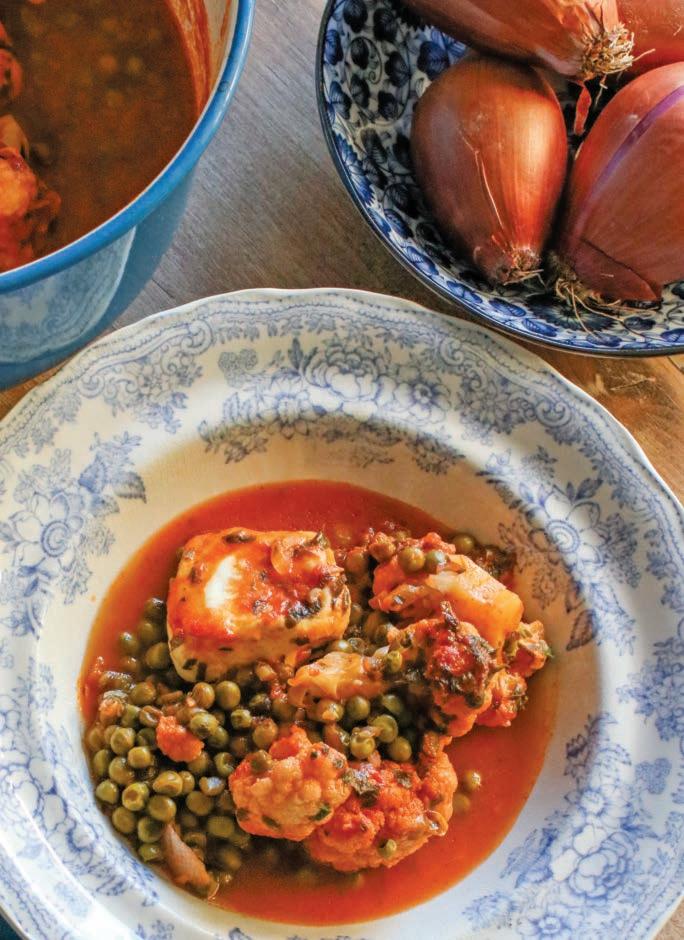
39 ISSUE 153 FEBRUARY 2023 IN SEASON &
This goes well with goat cheese, grilled chicken or lamb, and also with salmon.
Serves 6 as a side
YOU WILL NEED:
6-8 kale leaves
1 can of chickpeas, rinsed and drained 300g of cooked black Venere rice arils of 1 pomegranate
a handful of dill
a handful of mint
1 tablespoon of tahini juice of 1 lemon
6 tablespoons olive oil
a sprinkle of ground cumin salt to taste
1. Drain the chickpeas and rinse them well. Wash and finely chop the dill and mint.
2. Make the dressing by whisking together the tahini, lemon juice, and olive oil. Set it aside.
3. Remove the stalks from the kale and chop the leaves very finely. Mix all the ingredients together and toss with the dressing. Season and serve.

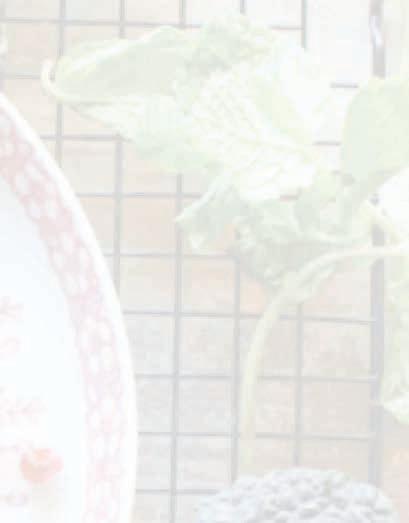
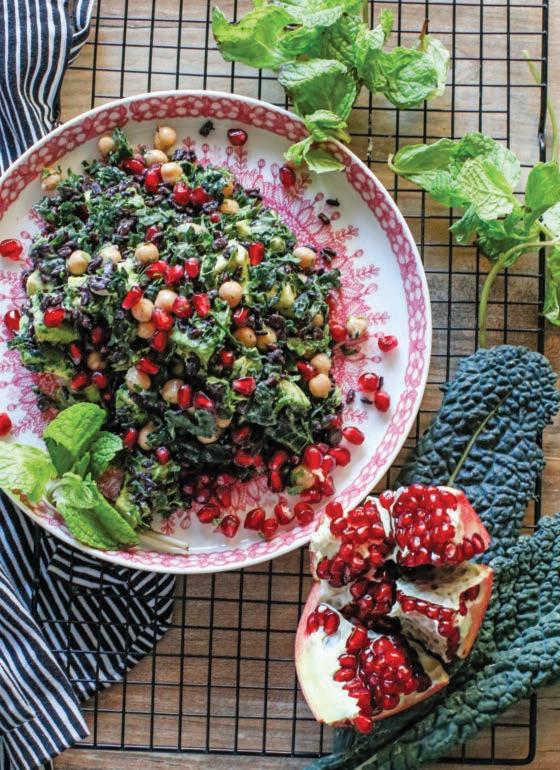
40 ISSUE 153 FEBRUARY 2023 & IN SEASON














bov.com/homeloans | @bovofficial Fill in online application 01 BECOME A HOMEOWNER APPLY ONLINE Homeowners 04 Upload documents 02 Track your application process 03 CONTACT US All loans are subject to normal bank lending criteria and final approval from the Bank. The term of the loan must not go beyond retirement age. Issued by Bank of Valletta p.l.c. 58, Triq San Żakkarija, Il-Belt Valletta VLT 1130. Bank of Valletta p.l.c. is regulated by the MFSA and licensed to carry out the business of banking in terms of the Banking Act (Cap. 371 of the Laws of Malta).
YOU WILL NEED:
6 large potatoes
100g butter
100ml fresh cream
a sprinkle of nutmeg
salt and white pepper
6 tuscan kale leaves

6 rashers of steaky or collar bacon
a knob of butter
2 spring onions
some fresh rosemary
Serves 4 to 5 as a side
1. Remove the stems from the kale and finely chop the leaves. Finely chop the bacon and spring onions.
2. Cook the onions until they so en. Add the bacon and kale and cook them for a couple of minutes.
3. Boil, drain, and mash the potatoes, adding the cream, bu er, nutmeg, and seasoning.
4. Mix half the kale into the potatoes and serve the remaining half over the top with more bu er
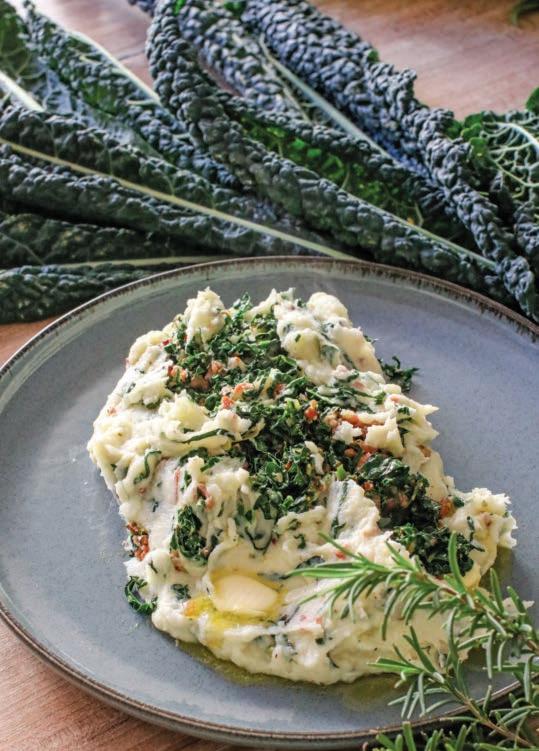
42 ISSUE 153 FEBRUARY 2023 & IN SEASON

Old World vs New World Wines
Historically, wines from Europe and the Mediterranean were considered superior to wines from the newer wine-making regions. Andrew Azzopardi explores the shi ing geography of quality wine.

All this wine jargon can get rather complicated. “Old World” wines refer to the original winemaking regions of Europe, the Middle East, and Northern Africa, while all of the other winemaking locations – such as America, New Zealand, Australia, Chile, Argentina, and certain Asian countries – are considered to be the “New World”. If one were to look at wines from Europe and compare these to wines from America, New Zealand, and Australia, we o en find there are certain characteristics that tell them apart. We could say that the European wines are more mineral, restrained, and with high acidity, whereas the New World wines are often more fruit-forward, juicy, and lower in acidity. These traits are nothing more than a result of the climate, where the New World is generally warmer and sunnier than the Old World.
I still remember Maltese wine aficionados back in the late 70s and early 80s agreeing on the superior quality of
French and Italian wines when compared to wines from Australia and California. It wasn’t even a discussion. They would state how those over-oaked Californian Cabernets Sauvignon and relatively brazen Shiraz from Australia were cheaper or inferior in quality.
It was considered common knowledge that New World wines were fuller, sweeter, and possibly more approachable for the novice wine-lover, but despite their charming and boisterous character, they were considered brash and unsophisticated at best, and downright cheap or crude at worst.
In fact, New World wines were considered so inferior that, in 1976, when the late Steven Spurrier wanted to organise a blind tasting between the very best of “Old World” Burgundy & Bordeaux and “New World” California, the snobs in the world of wine laughed at the very concept. Many thought it would be an embarrassing walk-over for the French, but Spurrier was so confident of the
44 ISSUE 153 FEBRUARY 2023 & WINE
Snubbing anything that’s New World is now a thing of the past.
improvements of Californian wines, he went ahead. Despite nine out of the eleven judges being French, the declared winners were the 1973 Californian Chardonnay Chateau Montelena in the white wine category, and the 1973 Napa Valley “Stags Leap” Cabernet Sauvignon was the outright winner in the red wine category.
As you can imagine, chaos ensued and some judges even demanded their ballot cards to be returned and proceeded to criticise the whole event. But the results were clear. The myth that Californian wines are lower in quality had forever been debunked. The result from this event, coined “the Judgement of Paris” not only gave California the boost it needed, it also gave confidence to the rest of the New World. Chilean, Argentinean, Australian, and “Kiwi” wine producers found a renewed belief in their wines and the world took notice.
It is no longer the case that we can pigeon-hole a country or region’s style of wine. A er the “Judgement of Paris”, winemakers across the Old World started believing in the terroir of the New World areas. Napa Valley winemaker Robert Mondavi and Baron Philippe de Rothschild, owner of the world famous Château Mouton Rothschild in Bordeaux, quickly joined forces in 1978 to create “Opus One” which soon became a legendary wine out of Napa Valley using typical Bordeaux grape varieties in their blend. Opus One was also be said to combine the beauty of the old world with the new world. The conspicuous differences between the two worlds were starting to fade. With travel becoming cheap and the “flying winemakers” emerged, seasoned oenologists and consultants travelled between continents spreading their knowledge and consulting on blends and styles, further reducing the disparity between the styles of Old World and New World. It was no longer only about typicity, but more about quality being the end game.
However, we must acknowledge that there still are fundamental differences between wines from the Old World and the New World. Irrelevant of quality, most Californian Cabernet Sauvignon is opulent and chock-a-block full of sweet sunshine, while Australian reds tend to have menthol nuances and New Zealand Sauvignon Blanc bursts with tropical flavours we love so much. But the old adage of Old World needing bo le age and New World being full-on juicy is absolutely not true any longer.


It is incredibly interesting to see how different wineries from the New World Australia can have such different styles yet are of equal top quality. For example, there’s no disputing that the three biggest guns in Australia are Penfolds “Grange”, Henschke’s “Hill of Grace”, and Torbreck’s “The Laird”. These wines are all complex and age-worthy Southern Australia Shiraz, yet are so different in style. All upward of €500 a bo le, “Hill of Grace” and “The Laird” o en compared to old world Syrah from Rhône’s Northern Valley, whereas “The Grange” has a more opulent New World style to it. Similarly, certain Shiraz from New Zealand even label their wines as Syrah, suggesting a style similar to Northern Rhône, whereas others prefer to use the more popular term Shiraz, implying a fuller, more fruit-forward style. But is it just the so-called New World wines that have changed? Absolutely not.
The forward, more approachable styles of Australia, California, and New Zealand have influenced regions such as Bordeaux and Rioja which have started producing wines that are ready to drink much earlier than before. I have even tasted some 2018 Bordeaux wines that are incredibly so , approachable, and balanced at such a young age. This was highly unlikely for these same Châteaux in the 80s and 90s but due to the influence of the New World, they have adapted. Château Clerc Milon is also proudly displaying its splash of Carmenère in the blend. While it is only a tiny fraction of the blend at around 1%, I’m pre y sure other wineries will follow suit. We’ve already heard that Bordeaux have recently introduced six new grape varieties that are expected to cope with climate change be er and I can only guess that Carmenère might start being more prominent in future blends.
While the differences between the Old World wines and New World wines are definitely less evident, we are seeing wines from both sides of the historical fence that have never been be er in quality. I have no doubt that, due to the awesome successes in the New World, the Old World have upped their game to remain at the forefront of quality winemaking. Snubbing anything that’s New World is now a thing of the past and I would hasten to say that many sommeliers find it easier to sell exotic, fruit-forward New World wines over the be er known, classical wines from the Old World. n
45 ISSUE 153 FEBRUARY 2023 WINE &
After the “Judgement of Paris”, winemakers across the Old World started believing in the terroir of the New World areas
Andrew Azzopardi is a wine specialist certified by the Wines and Spirit Education Trust.


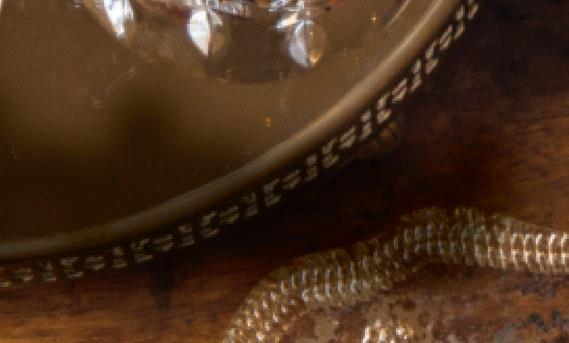
46 ISSUE 153 FEBRUARY 2023 & SWEETS Delicious
Desserts
Unfussy desserts are a dream to make. Most of these recipes need little preparation, minimal to no cooking time, and taste heavenly.


Photography: Corinne Vella
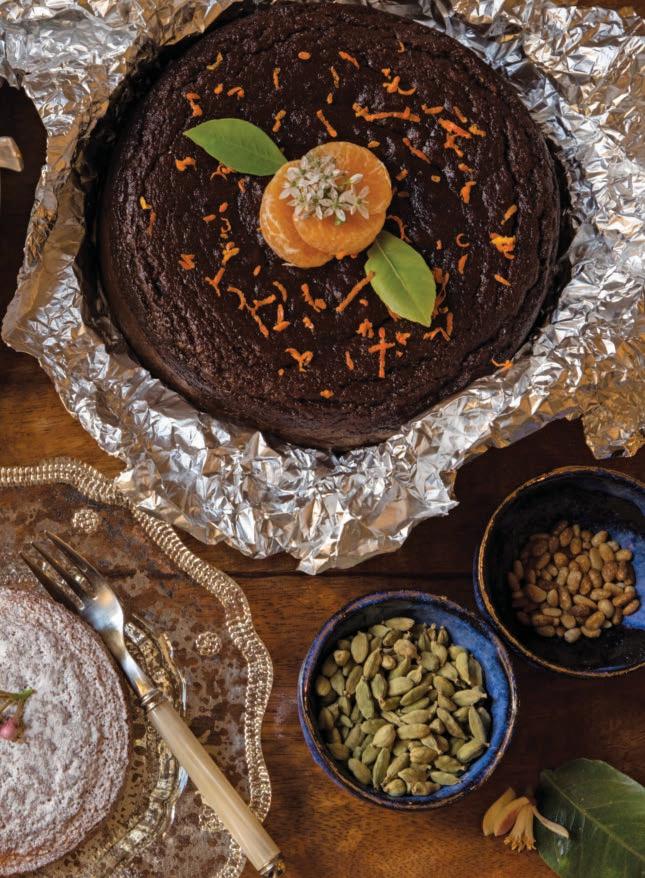
47 ISSUE 153 FEBRUARY 2023 SWEETS &
Honeyed Apricots and Dates

This can be stored in a sealed jar until needed.
Serves 4
YOU WILL NEED
150g dried apricots
110g fresh dates
175g honey
500ml water
2 bay leaves juice and zest of 1 orange
2 green cardamom pods, lightly crushed
TO SERVE
Greek yogurt
1 teaspoon orange flower water chopped pistachio nuts pomegranate arils (optional)

1. Stir the honey in the water over a low heat until it dissolves. Add the juice, zest, cardamom, and bay leaves and boil the mixture to a syrup.
2. Add the apricots and let them simmer for 35 minutes. Top up the liquid with boiling water, if necessary.
3. Turn off the heat and let the apricots stand in the warm syrup for 20 minutes, then add the fresh dates and let the fruit soak in the syrup overnight.
4. Drain the syrup into a clean pan, reserving the fruit. Boil the syrup down till it thickens, then set it aside to cool. Store the fruit in the cooled syrup until serving time.
5. To serve, scoop some fruit into a small bowl and drizzle with a li le bit of the syrup. Add a dollop of Greek yogurt, lightly whipped with the orange flower water, and sprinkle with pistachios. Alternatively, serve the yogurt on the side.
48 ISSUE 153 FEBRUARY 2023 & SWEETS
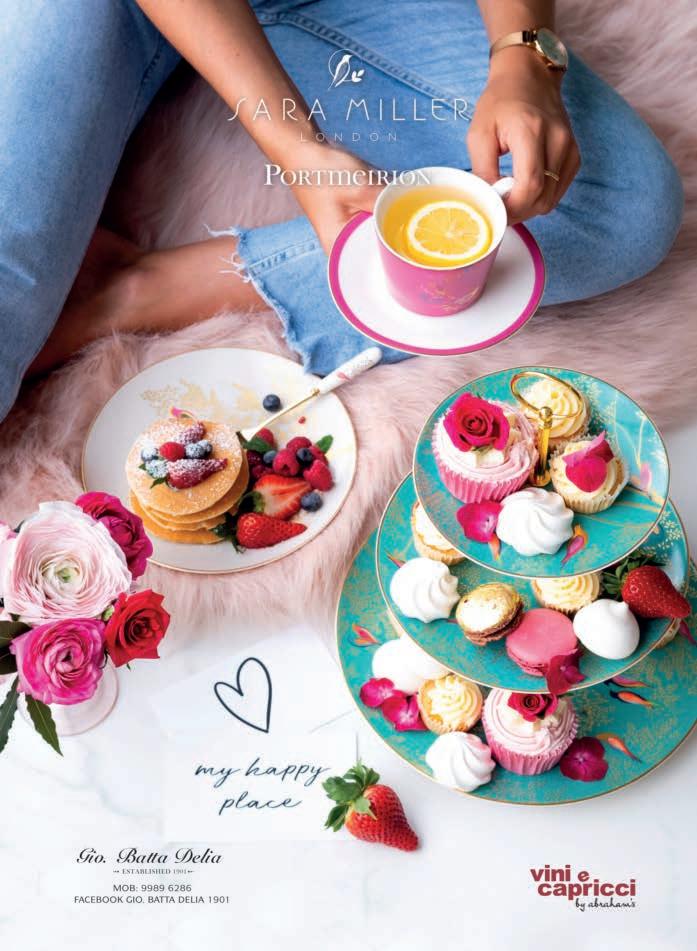
Jewelled Chocolate
An easy-make on a rainy a ernoon, this can be a fun project for bored children. Simply choose topping ingredients suited to their age and keep a close eye on the molten chocolate.
Makes 1 bar.
YOU WILL NEED
200g dark chocolate
50g very dark chocolate
1 tablespoon crushed
maple honeycomb
1 tablespoon pistachio nuts
1 tablespoon pumpkin seeds
orange zest salt crystals (optional)
FOR THE MAPLE SYRUP HONEYCOMB
100g caster sugar
60 ml maple syrup
1 ½ teaspoons bicarbonate of soda
1. To make the honeycomb, start by lining a heatproof plate with non-stick paper.
2. Stir the sugar and maple syrup together in a small pan and set it on a medium heat.
3. Without stirring, turn up the heat and let the mixture boil for around 3.5 minutes.
4. Remove the pan from the heat. Quickly whisk in the bicarbonate of soda and let the mixture foam up. Pour it out onto the lined plate and put it aside to set.
5. Break up the dark chocolate into a heatproof bowl and place over a pan of boiling water till it melts. Check and stir it frequently to make sure it doesn’t caramelise and burn. You can also melt the chocolate in a microwave oven. Do this is short bursts to prevent it burning.
6. Pour the molten chocolate onto a sheet of non-stick paper and use a spatula to spread it out into a rectangular shape. Let it set slightly.
7. Sca er the pistachios and pumpkin seeds over the chocolate and lightly press in small chunks of honeycomb and salt crystals (if using)
8. Melt the very dark chocolate and use a teaspoon in a swirling motion to drizzle this over the topping, then sca er the orange zest and put the chocolate aside to set.

50 ISSUE 153 FEBRUARY 2023 & SWEETS
If you plan to serve this to anyone who’s allergic to gluten, check the ingredients list on the bicarbonate of soda and the baking powder to make sure that the starch content is gluten-free.
Serves 8
Gluten-free chocolate and clementine cake
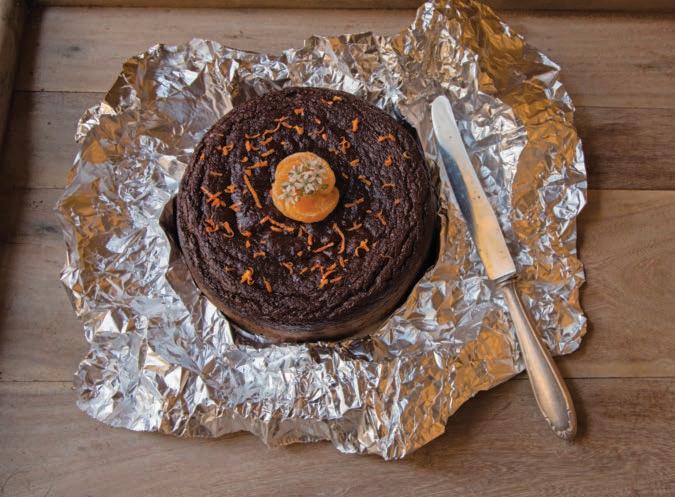
YOU WILL NEED
3 seedless clementines, unwaxed
5 large eggs
210g ground almonds
240g caster sugar
50g cocoa powder, unsweetened ½ teaspoon bicarbonate of soda
1 generous teaspoon baking powder
1. Boil the clementines until they are very so (around 50 minutes) and let them cool. Roughly chop them, skin and all, and then blend them to a rough paste.
2. Preheat the oven to 180°C.
3. Add all the other ingredients to the clementine paste and use a mixer or blender to combine them into a ba er. Pour this into a cake tin lined with non-stick paper and bake for an hour.
4. Let the cake sit in the tin for 10 minutes, then turn it out onto a wire rack to cool down. Garnish with clementine zest.
51 ISSUE 153 FEBRUARY 2023 SWEETS &
Cardamom and Lemon Sponge
Makes two small cakes
YOU WILL NEED
80g unsalted butter
80g self-raising flour
50g golden caster sugar
2 eggs
35g honey
½ teaspoon baking powder
lemon zest
ground cardamom seeds
TO DECORATE
sifted icing sugar
1. Preheat the oven to 190°C and mix the flour and baking powder in a bowl.
2. Put the bu er in a bowl and melt it by giving it a short blast in a microwave oven. Let it cool down without se ing.
3. In a separate bowl, whisk the sugar, eggs, and honey together until the mixture runs off in ribbons when you li the whisk. The texture of the mixture should be moussey.
4. Fold in half the bu er and half the flour mixture. Then add the rest of the bu er and flour, along with the lemon zest and cardamom seeds, and fold the ingredients into the mixture.
5. Pour the ba er into two small round cake tins and bake in the preheated oven until the cake firms up and turns golden (around 15 minutes).
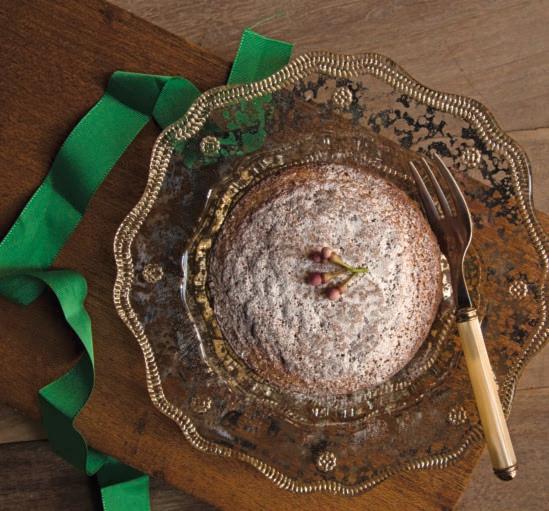
6. Let the cakes cool in their tins for around 10 minutes then turn them out onto a cooling rack.
7. Serve topped with fresh fruit or simply dredged with icing sugar.
52 ISSUE 153 FEBRUARY 2023 & SWEETS
Light and moreish, this is perfect for serving with freshly brewed co ee.



ANNIVERSARY PROMOTION PRICES ASK FOR DETAILS
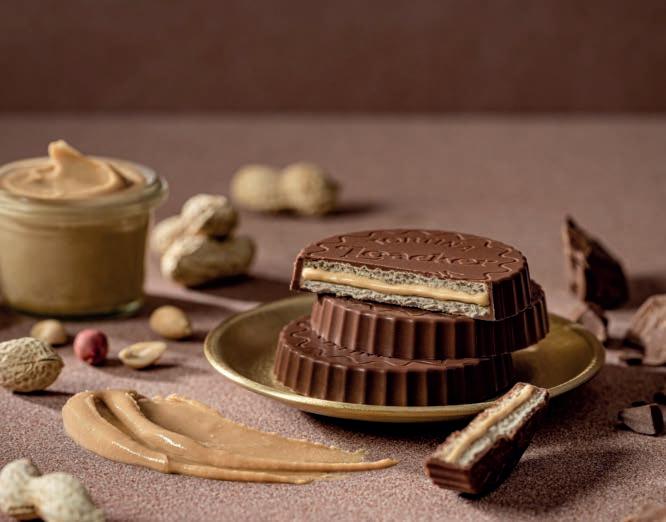


















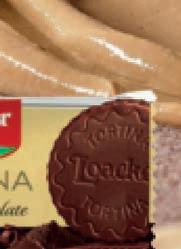










































































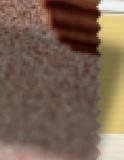





























NEW The delicious new flavor of goodness
goodness!
PEANUT BUTTER Pure
Pomegranate Verrines
YOU WILL NEED
cardamom lemon sponge
(see recipe on page 52)
apricot & honey syrup
(see recipe on page 48)
pomegranate arils
Greek yogurt
toasted pine nuts
amaretto
pomegranate molasses
pistachios
1. Tear the sponge into small chunks and cover the bo om of each serving glass. Drizzle with amare o. Top the sponge with toasted pinenuts
2. Add another layer of sponge chunks and drizzle it with pomegranate molasses. Sprinkle in the pomegranate arils.
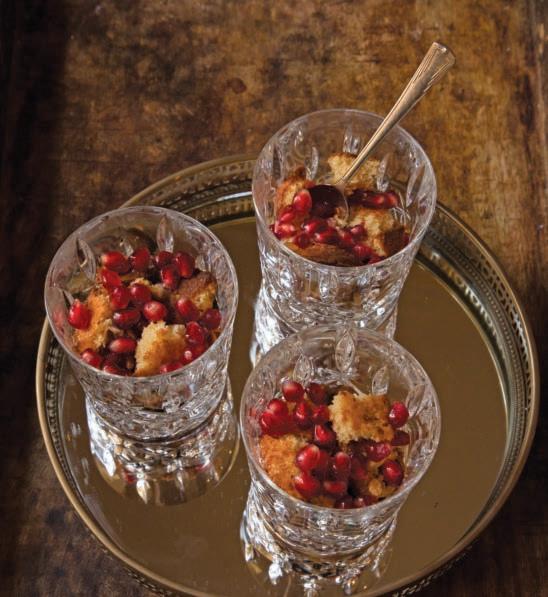
3. Add another layer of sponge and drizzle it with apricot honey syrup. Top with more pomegranate arils and toasted pine nuts.
4. Store the desserts in the fridge until needed and then serve with lightly whipped Greek yogurt on the side.
55 ISSUE 153 FEBRUARY 2023 SWEETS &
This no-cook dessert can be assembled in minutes.

56 ISSUE 153 FEBRUARY 2023 & TRANSFORMATION
A noughties house gets a makeover, giving it a fresh new look
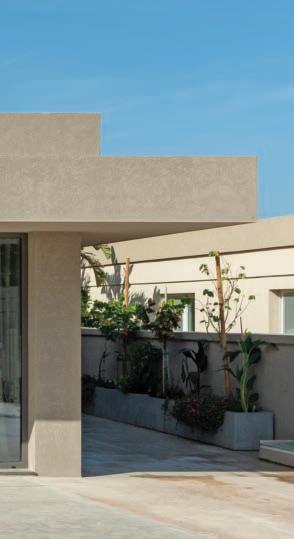
Architecture: A Collective


Structural engineering: MA Architects
Photography: Alex Attard

57 ISSUE 153 FEBRUARY 2023 TRANSFORMATION &
“This villa is from the early noughties,” the architect Steve Risio says as he looks through several photographs. “It sounds recent, but that was a couple of decades ago,” he adds with a smile. Originally, this was one large house, later divided into four – 2 pairs of semi-detached villas, one pair each for two sisters. The buildings sit near the crest of a hill overlooking an expanse of open countryside. In the distance, there are views of the sea, marginally blighted by the haphazard lines of coastal development. The villa Steve talks about serves as the owners’ family home. A racted by the be er views, they wanted to move in from the house next door, planning to let out their current home to tenants.
Their “new” home was in want of a makeover. Dark, closed spaces needed to be opened up; the terrace overlooking the garden area was bathed in sunlight but too exposed to the elements to be enjoyed fully. Some aspects of the design and layout didn’t really work to their full potential. “The house felt older than it is,” Steve says.


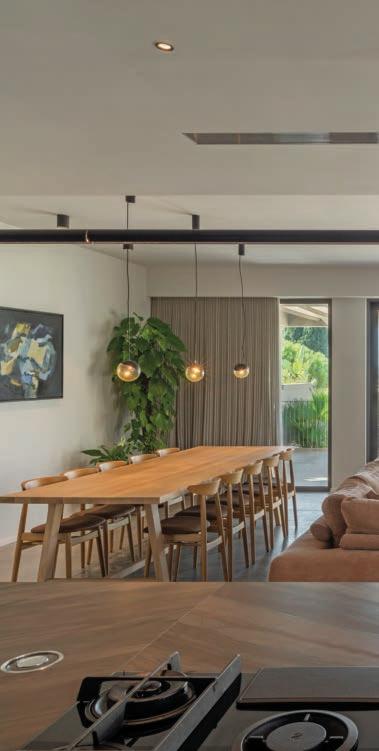
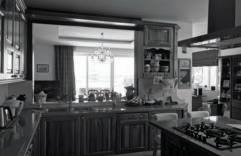
58 ISSUE 153 FEBRUARY 2023 & TRANSFORMATION
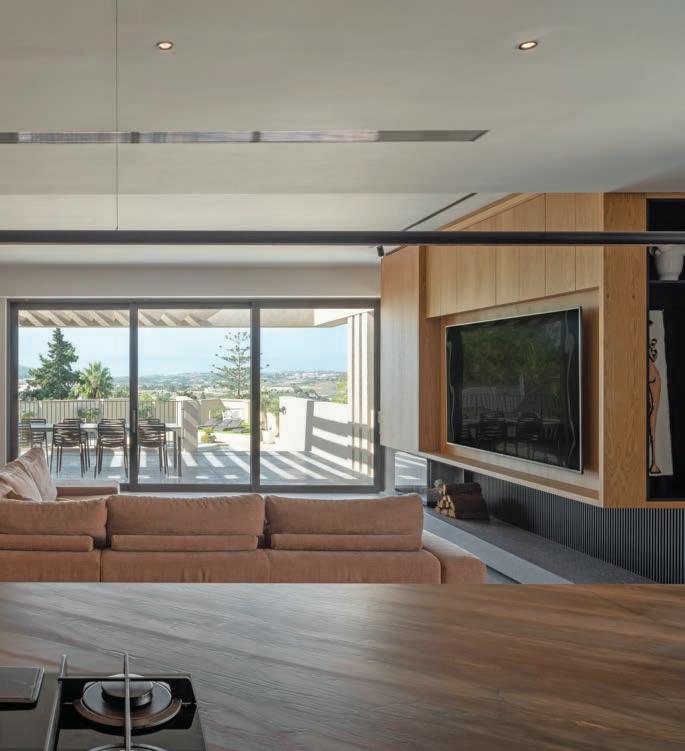
59 ISSUE 153 FEBRUARY 2023
&
TRANSFORMATION
Removing a partition wall opened up the kitchen, dining, and living area. The indoor dining table and chairs from camilleriparismode and light fittings by Elektra complement the sleek design aesthetic.
What was formerly an L-shaped kitchen, living, and dining area has been remodelled to create one large open space where functional boundaries are defined by the furniture layout rather than by physical partitions. “We removed a partition wall to create the open space. A beam that replaced the load-bearing wall is concealed inside the soffit, along with the mechanical and electrical infrastructure that support the air conditioning and lighting. Down at floor level, the architects created a long, monumental kitchen island in a striking dark brown marble veined in turquoise.
Each functional area in the open plan space either overlooks the side garden or the dining terrace. The long indoor dining table is positioned perpendicular to the terrace door, enabling everyone seated at table to take in the view. The kitchen is positioned at the inner end of the space, but the open sight lines now mean one can look all the way outside while preparing a meal indoors.




60 ISSUE 153 FEBRUARY 2023 & TRANSFORMATION
The soft-tones of the neutral pallette continue seamlessly into the interior. The smoothness of the microcement flooring by Rado Flooring enhances the soothing effect.

In the living area, one half of the couple wanted a large TV, the other wanted a wood-burning fireplace. “That set the parameters for the central furniture piece. Restrained by the floor to ceiling height, we needed to ensure that the TV was located at a comfortable viewing height while accomodating the wood burning fireplace below,” Steve says. Both the TV and fireplace have been set into the same volume. The TV equipment is stored above behind wood partition and accessed through a magic eye. The L-shaped sofa had been reupholstered to work with the soft-toned, largely neutral pale e.

One of the problems with the existing house was that the dining terrace was unusable. In summer, it was too hot and there was no breeze. The owners wanted to be able to use the terrace all year round so installing an awning was out of the question. The architects studied the sunpath and came up with the idea of a louvred canopy that provides shade without heat gain while allowing the sun to infiltrate in winter, relying on MA Architects to help them realise the structural design.

62 ISSUE 153 FEBRUARY 2023 & TRANSFORMATION

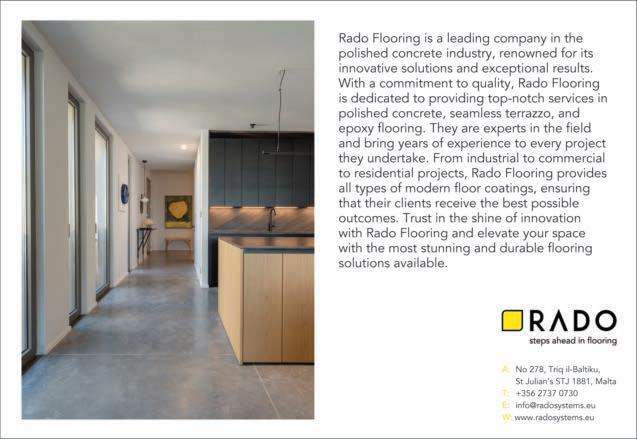
The construction of a louvred canopy has transformed the dining terrace into a welcoming space even in the height of summer.
Microcement flooring by Rado Flooring enhances the effect of the shifting light and shadow patterns. The large aluminium sliding doors by Adore More can be drawn back, blurring the boundary between the indoor and outdoor living and dining areas.

64 ISSUE 153 FEBRUARY 2023 & TRANSFORMATION
“Architects are dreamers who tend to push the structural engineer to design the slimmest lightest structure possible,” Steve says. Three slim columns instead of one wide one have been installed on the side of the canopy to support the cantilevering elements whilst echoing the design of the canopy. In the morning light, the structure casts long shadows, creating a shifting display of sunlight and shade. Round the side of the house, A Collective extended the proportion of the windows, opening them up all the way down to the floor to create a rhythm and introduce light into the darker parts of the house. The external staircase was remodelled and its railing replaced. At the front, the garage door opening was widened to fit two cars and a new bespoke ribbed garage door installed to make it look less industrial and less blatantly like a garage door. To the right of the garage, the wall-to-wall glazed doors of the front room were replaced with three floor-to-ceiling perforations flanked by columns, and an expansive full height glass window. Overhead, the pre-existing “bas relief” band has been extended outwards, unifying the façade. The rendering is neutral and aesthetically very relaxing.
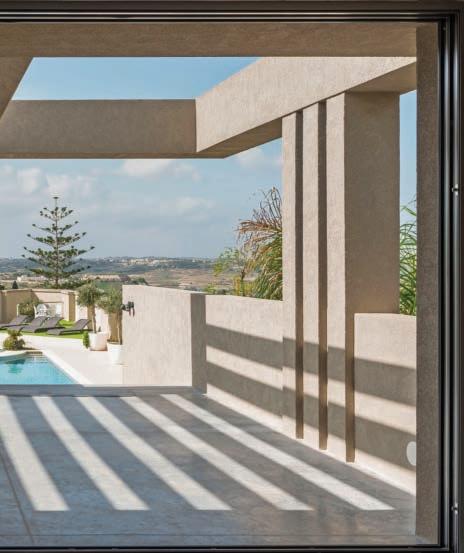
“Pure white can look stark and create too much glare,” Steve says.

65 ISSUE 153 FEBRUARY 2023 FRESH &
To give the main entrance a sharper definition, the overhead plane was drawn down and the door replaced with one in a bespoke ribbed design that echoes the garage door. On the inside, the “hallway” didn’t really exist. The space led off into two corridors, with flooring in glossy beige ceramic tile, which have now been replaced with monolithic concrete flooring. Here, too, the architects replayed the idea of the transluscent screen, installing a door with a timber-frame. The materials used are natural: concrete, marble, wood. “We avoid using faux materials, such as ceramic that imitates wood” Steve says.


In the master bedroom, the floor plan was redefined. The walls of the walk-in wardrobe were demolished, their position shi ed, and an ensuite shower room was installed. The same soft-toned neutral palette has been applied throughout, making the place feel homogenous. n

66 ISSUE 153 FEBRUARY 2023 & TRANSFORMATION
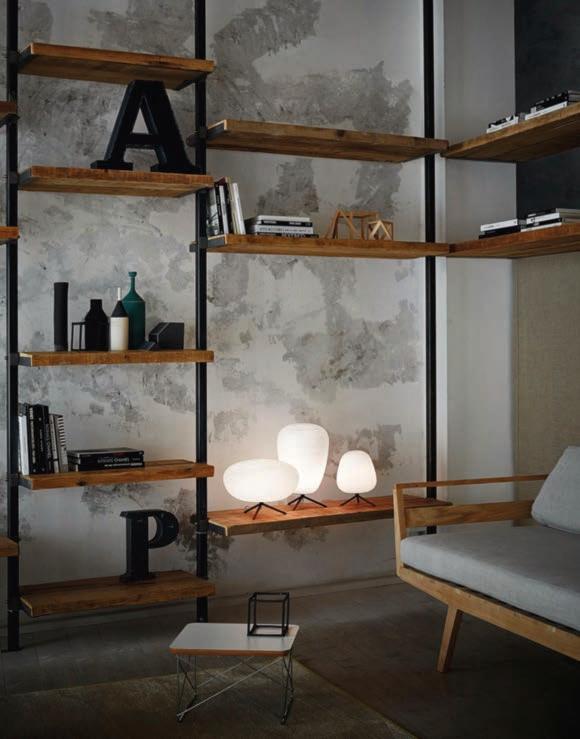

Rituals tablelamps design:Ludovica+RobertoPalomba foscarini.com 119,MillStreet, Zone 5, Central BusinessDistrict,Qormi,CBD 5090,Malta T +35625463000—info@elektra.com.mt www.elektra.com.mt
Photo:KasiaGatkowska
COMPACT LIVING
Small spaces pose big challenges, particularly in a historic city. A sensitive and innovative design approach has created two small Valletta units that can function as standalone units or be combined into a single residence.
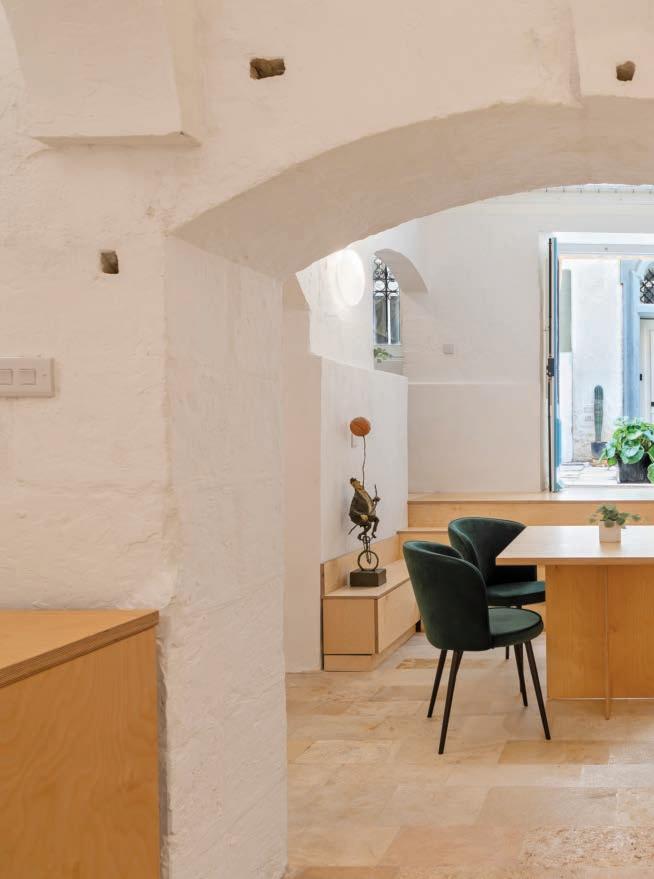
Architect: Elisa Grech
Photography: Alex Attard
68 ISSUE 153 FEBRUARY 2023 & VALLETTA
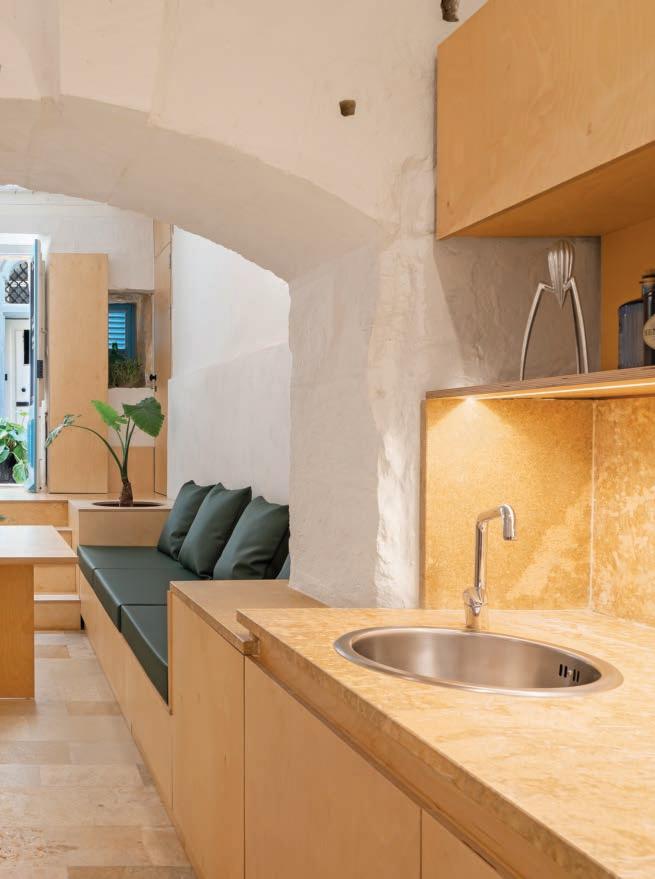
69 ISSUE 153 FEBRUARY 2023 VALLETTA &
When Elisa Grech was commissioned to reorganise and design two adjacent small units in Valle a she had to find smart solutions. The main entry level is partially below street level, which created problems with humidity, lack of cross-ventilation, and natural light. The two properties needed to function flexibly as standalone units or as one larger unit, offering guests a comfortable stay on a stepped street close to Valle a’s main beach, School of Art, Valle a Design Cluster, and main entertainment area. Their limited size and physical arrangement needed an inventive and innovative approach to create a fun, bright and vibrant space within a historical shell.

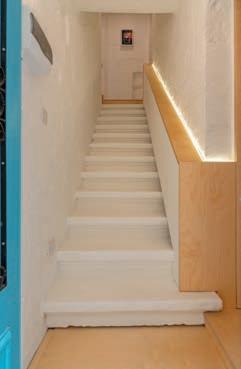

70 ISSUE 153 FEBRUARY 2023 & VALLETTA
THE CONCEPT WAS TO PULL THE STREET INTO THE PROPERTY, BLURRING THE BOUNDARIES BETWEEN INTERNAL AND EXTERNAL SPACE.
Start at the oor and build your way up to create rooms with personality, from our diverse range of engineered, veneered, laminated & vinyl ooring to skirting, wall mouldings, 3D panels, cornices, indirect lighting pro les, curtain hider pro les & ceiling roses.

|
|
Creating spaces worth living in. Triq Tal-Balal, San Gwann | 2095 9595 | info@brands.com.mt | www.brands.com.mt YOUR EXPERT IN WALL COVERING AND FLOORING residential
commercial
indoor
outdoor
|
The location, social context, and surrounding topography informed the thematic approach to the design, serving as an inspiration for the design. The concept was to pull the street into the property, blurring the boundaries between internal and external space. This effect was created by constructing timber stairs designed to be comfortable and generously proportioned for si ing on, and that transform into functional furniture pieces within the space: a planter, sofa, kitchen, handrail, and storage area, and a mask for internal services such as ventilation ducts that run through the properties.



72 ISSUE 153 FEBRUARY 2023 & VALLETTA
DESIGNING THE STRUCTURE INVOLVED HOURS OF RESEARCH AND PROTOTYPING.
Vanwood Furniture built the bespoke furniture and timber stairs, which were inspired by the location on one of Valletta’s stepped streets. The sculpture (top left, private collection) is by Andrew Diacono.


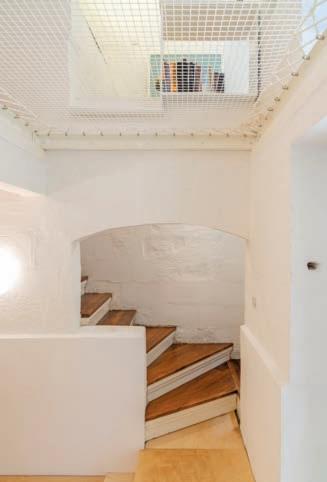

73 ISSUE 153 FEBRUARY 2023 VALLETTA &
The boundaries between internal spaces are not partitioned but curated through colour to give the impression that one space serves all the functions needed by day and by night. The only doors within the space are on entering the two units, the ones that separate them, and the two that lead into the respective bathrooms.
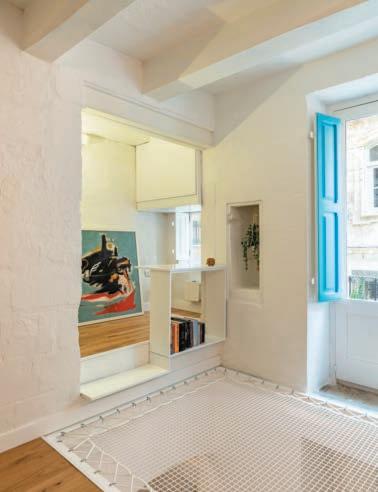
Floor space has been sacrificed to improve the habitation and environment of the property. The timber beams and stone slabs that once separated the two floors have been replaced by a lightweight net suspended floor, inspired by the boats sailing the harbour just metres away. This created a double height space just inside the main entry, allowing the ground floor to “breathe”, improving ventilation throughout thanks to the stack effect, and drawing light into the lower level from the balcony and windows on the floor above.
“The Net” allows for an unusual experiential resting space and breathable perforated floor plate that allows enhanced ventilation in the property. Designing the structure involved hours of research and prototyping, with a steel frame being fabricated in Malta under the guidance of a supplier in France who fabricates custom-made nets for catamarans.

74 ISSUE 153 FEBRUARY 2023 & VALLETTA
“The Net” was designed and created specifically for the space. The painting (private collection) is by Samuel Sultana.



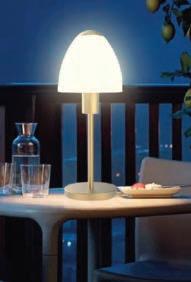

Whitehouse Bldgs, Mountbatten Str, Blata l-Bajda, Hamrun T 21 241 307 M 7949 7016 E info@itc-malta.com W www.itc-malta.com ENHANCE YOUR HOME WITH THE RIGHT LIGHTING THE PERFECT LIGHTING SOLUTIONS
Cross-ventilation was increased by installing an air ingress motor, which supplies the kitchen at the far end of the property, and extractors which aid the flow and circulation or air. The design detailing conceals these services within the continuous bespoke timber furniture which runs through both properties. The pipe which supplies the kitchen with fresh air is concealed behind the steel structure that supports the mezzanine and encased beneath the timber storage at bedroom level at first floor. Colour plays an important part in the overall design. Each unit is defined by its own colour accents – in the micro-cement toppings and sleeping alcoves – which are complementary rather than contrasting, easing the transition when the two independent units are used as one. The rest of the material pale e is simple but technically functional.
r Timber furniture, doors, and flooring add warmth and texture to the interior. The engineered hardwood floor in the green unit was supplied by Brands International.

f Colour accents define the functional spaces in both units. Sanitary fittings supplied by Satariano complete the look in the bathrooms in both the green and pink units.
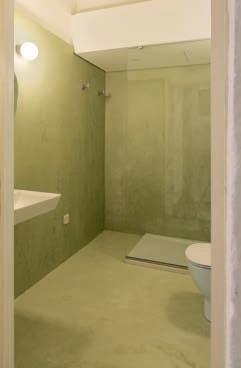
76 ISSUE 153 FEBRUARY 2023 & VALLETTA
VANWOOD SPECIALISES IN WALL CLADDING, INCLUDING INSERT DOORS MADE FROM NATURAL WOOD. FOR CUSTOM MADE FURNITURE AND FINISHES WITH A PERSONAL TOUCH, CONTACT US.


Vanwood Furniture 45, Luret Cutajar Street, Zebbug, Malta. Mobile +356 99495803 Vanwood Furniture
“We used special restoration dehumidifying plasters on the ground floor level so that the walls could be painted in white to brighten up the space,” Elisa Grech says. Maltese hardstone, traditional pa erned cement tiles and timber floors were installed throughout, and the use of “honest” materials like birch plywood, the conservation of the existing Maltese hardstone and Maltese tiles contributed to keeping the project within budget without compromising on design.


There was an element of future-proofing the project in the event that the market of one bedroom short-let flats becomes oversaturated, increasing the demand for larger properties. This was done through a sensitive design approach that caters for flexibility where the two small units may in the future be combined into one larger property, simply by unlocking a couple of doors.
Colour and lighting accents define the cosy sleeping nooks in both units. Lighting is by ITC, who supplied most of the light fittings throughout both units. The white and pink painting by Violet Kulewska was supplied by Lilly Agius Gallery.
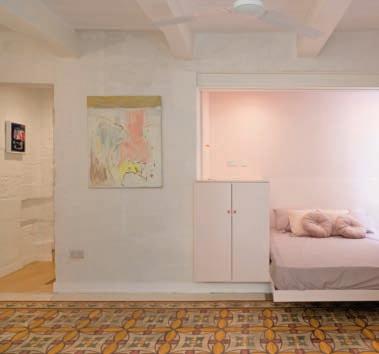
78 ISSUE 153 FEBRUARY 2023 & VALLETTA
The painting on the left is by Giulia Holland; the one on the right is by Austin Camilleri. Both paintings are in a private collection.
THE BOUNDARIES BETWEEN INTERNAL SPACES ARE NOT PARTITIONED BUT CURATED THROUGH COLOUR.
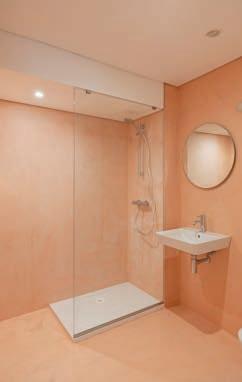


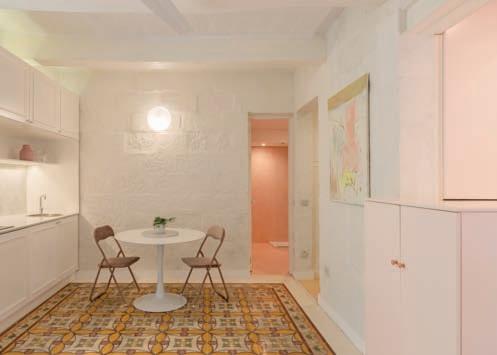
79 ISSUE 153 FEBRUARY 2023 VALLETTA &
Johannes Vermeer (1632-1675) is best known for the stillness and introversion of indoor scenes, many apparently painted in the same domestic setting where bright light pours in through a window, illuminating a human gure caught in a contemplative moment. Such is the intimacy of his paintings that it seems almost as though the viewer is part of the scene and that, at any moment, the subject of the painting might look up and notice that someone is there.
The artist was born in Delft, where he lived and worked, largely unrecognised in his lifetime having converted to Catholicism when he married, aged 21, in a firmly Protestant country. Little is known about the man behind the paintings and, among the Dutch masters, he remains the most enigmatic. There are no letters or notes, no personal effects by which the artist himself may be understood, but when he died, at the age of 43, he left behind a relatively small but remarkable oeuvre that is now scattered among institutional and private collections around the world.
Fewer than 40 Vermeer paintings are known to exist, with only a handful held in collections in his home country. Highly prized by their owners and very fragile – most were painted in the years 1655 to 1670 – Vermeer’s masterpieces are rarely lent out. Now, in what is likely to be a once-in-a-lifetime event, 28 of the paintings have been assembled in the first ever Vermeer retrospective at the Rijksmuseum in Amsterdam. Simply titled “Vermeer”, the exhibition has already generated much excitement among artlovers, selling well over 100,000 advance tickets by the time it opened last Friday – an
unprecedented number in the museum’s history.
Initially sparked by the planned closure of The Frick Collection for refurbishment, the Rijksmuseum exhibition draws together Vermeer masterpieces from the Frick and other owners in seven countries. “Girl with a Pearl Earring” is at home in the Rijksmuseum; “The Milkmaid” came from Mauritshuis in The Hague. The Frick Collection’s three Vermeers have travelled to Amsterdam for the first time in a century. Other pieces have been borrowed from collections from Washington to Tokyo.
“Vermeer” opened on 10 February at the Rijksmuseum in Amsterdam and will run until 4 June.
“Girl reading a letter at an open window”, Johannes Vermeer, ca. 1657-1659, Gemäldegalerie Alte Meister, Dresden. The painting of Cupid in the background was hidden from view for more than 300 years. It was revealed by an X-ray in 1979 and finally exposed a few years ago when restorers discovered that it was not Vermeer himself who had painted it over as this was done several decades after the painting was completed. The major change to the composition of the painting had already been carried out when it was brought to Dresden from the collection of the Prince of Carignan in France in 1742. The rediscovery of the Cupid paintingwithin-the-painting adds another layer of meaning to the work. The figure of Cupid treads on the masks of pretence lying on the ground, possibly signifying that sincere love overcomes deception and hypocrisy.

80 ISSUE 153 FEBRUARY 2023 T&F EXHIBITION
For advertising, contact Sean Ellul on +356 7921 0705 sellul@independent.com.mt The next issue will be out in April 2023 with The Malta Independent on Sunday.
Taking inspiration from the noble hues and majestic veining of marble. Heritage Azure is distinguished by a pale, refined blue background against which a deep rust-coloured vein stands out, making this marble perfect for pairing with warm-toned colours and materials. The Florim, Heritage Luxe collection features marble surfaces in bold, refined colours that add immense personality and character to the most exclusive of spaces. The richness of colours and graphic details of these products finds its maximum expression in the large sizes, designed to blend in with increasingly voguish large open spaces, or to illuminate more intimate surroundings. Available exclusively from Satariano, 122 Msida Valley Road, Birkirkara.

More than just a Sofa – Funinova, Swedish Comfort. Francis Day collection by Furninova stands out for its balanced and graceful look. Offered in various configurations both linear or corner in different fabric or leather finishes. Find the comfort you need & the style you love by choosing a Furninova Sofa. Exclusively from Satariano, Msida Valley Road, Birkirkara.


Just arrived at the BoConcept San Gwann showroom, is the chic, Italian-inspired sofa Bergamo. Unapologetic in both its simplicity and size, Bergamo sofa is a true showstopper among BoConcept’s designs and promises to be popular amongs those seeking the latest in interior trends. Its organic shape features clean, minimalistic lines that bring a refined elegance to the very last detail, such as the stitching to the base, armrest and backrest, designed to create a grid effect for a contemporary, high-end finish. Bergamo can be customised in various modules as well as in over 120 fabric and leather options. BoConcept, Triq tal-Balal, San Gwann. info@boconcept.com.mt
Introducing Super-Oh by Delta Light. An innovative series of slim black rings floating through space, finished with integrated LEDs specially designed to ensure a uniform and perfectly balanced light output, resulting in a very pleasant diffused lighting effect. A symbol of infinity, without beginning or end - the ultimate geometric symbol seamlessly integrated into architecture. Exclusively available at Elektra Ltd., Mill Street, Qormi. www.elektra.com.mt

TRENDS &

Triq L-Imdina, Zone 1, Central Business District, Birkirkara | T. 2546 4172 | malta@dorelan.it Triq L-Imġarr, Għajnsielem, Gozo | T. 2546 4152 | gozo@dorelan.it BEDS | MATTRESSES | PILLOWS & MORE












 KOZANIS KROCUS, NATURE'S MOST PRECIOUS ANTIOXIDANT
KOZANIS KROCUS, NATURE'S MOST PRECIOUS ANTIOXIDANT

























































































































































































































